
- View history
Voyager 6 was a deep space probe launched from Earth by the National Aeronautics and Space Administration (NASA) in the latter half of the 20th century . The sixth probe in the Voyager series , it was designed to collect data and transmit it back to Earth. ( Star Trek: The Motion Picture )
- 1 Technical information
- 3.1 See also
- 3.2 Background information
- 3.3 Apocrypha
- 3.4 External link

Technical information [ ]
Voyager 6 was equipped with an antenna and a ground test computer , for use in communicating with Earth. It was designed to transmit a signal relaying its readiness to transmit the information gathered, and to do so upon receipt of a code signal instructing the computer to transmit the data. ( Star Trek: The Motion Picture )
History [ ]
During its mission, Voyager 6 disappeared into what was once called a black hole (see V'ger ), emerging on the other side of the galaxy , where it fell into the gravitational field of a planet populated by a race of living machines. The inhabitants found the probe to be one of their own kind, primitive, yet kindred. Discovering its simple, 20th century programming, which directed Voyager to collect all data possible and return that information to the creator, the machines interpreted it literally, and constructed a massive vessel around the probe in order to facilitate that directive. On its journey back to Earth, it amassed so much knowledge that it achieved consciousness itself, becoming a living thing. In the 2270s , the entity was detected by Starfleet en route to Earth, and was intercepted by the USS Enterprise , whose crew was able to discover the fate of the long-lost probe. ( Star Trek: The Motion Picture )
Appendices [ ]
See also [ ], background information [ ].
According to Star Trek Chronology , Voyager 6 was launched in 1999 . According to Decker's line in the movie, however, it was launched " more than 300 years ago ". This suggests a launch date sometime before or in the early 1970s . In the real world, the actual launches of the first (and only) two Voyager probes took place in 1977.
Star Trek: The Magazine Volume 2, Issue 8 , p. 106, also uses the Star Trek Chronology 's 1999 date, noting that " Voyager VI " [sic] was officially approved in May of 1972 , and that all six of the Voyager series were built identically of 65,000 individual parts, including a radioisotope thermoelectric generator, plasma and cosmic ray detectors, and a data storage capacity of 500 million bits.
The fictional Voyager 6 probe around which V'ger was built, was actually a full-scale mock-up of the real world Voyager 1 and 2 probes of NASA's Jet Propulsion Laboratories (JPL). JPL's director John Casani agreed to loan the model to the studio in October 1977, mere months after the actual Voyager probes were launched in August and September that year. Then Star Trek: Phase II (the immediate predecessor of The Motion Picture ) Producer Robert Goodwin reported in a progress memo, dated 21 October 1977, " After your conversation with John Casani at Jet Propulsion Laboratories, JPL has agreed to loan us the mock-up of the Voyager, to be used as part of our set as the interior of the Alien Spaceship [note: indicating that the name V'ger had not yet been conceived at the time] . Joe Jennings and Matt Jefferies attended a briefing in JPL last night in the Voyager and Joe Jennings will return there next week with Bud Arbuckle to get measurements so that we can incorporate this large full-scale mock-up into our plans for the set." ( Star Trek Phase II: The Lost Series , p. 52) The text commentary on the Star Trek: The Motion Picture Director's Edition DVD even stated that JPL was willing to even go a step further and loan the production an actual engineering duplicate of the Voyager spacecraft, but the studio declined, saying that the risk of the duplicate being damaged on the set was too high.
Apocrypha [ ]
The William Shatner novel The Return , in which Kirk and Picard join forces to lead an assault on the Borg homeworld and end the recent Borg/ Romulan alliance once and for all presents the theory that a Borg transwarp conduit consumed the probe rather than a black hole, and that the planet seen by Spock was in fact, the Borg homeworld . The suggestion continues that the Borg assimilated the probe, yet the assimilation went "afoul" and changed Voyager 6 into a more sentient being.
Star Trek: Legacy presented the theory that the 20th century Borg civilization was a peaceful race. When V'ger encountered them, they studied its programming, repaired the probe, and sent it on its task. When V'ger returned to the Sol system it could not find its creator, but "a biological infestation." The probe returned to the Borg homeworld and joined with them, and its programming propagated throughout the Collective . Something of a civil war broke out. Massive amounts of knowledge, including the location of Earth, were lost in the resulting conflict, and the Borg of the 24th century were born.
In Star Trek Online , the mirror universe counterpart of V'ger , known as "the Other", is encountered in the 25th century. The probe at its core is known as Conqueror 6 , sent out by the Terran Empire in the 20th century to find new worlds to dominate.
External link [ ]
- Voyager 6 at Wikipedia
- 2 ISS Enterprise (NCC-1701)

- The Contents
- The Making of
- Where Are They Now
- Frequently Asked Questions
- Q & A with Ed Stone
golden record
Where are they now.
- frequently asked questions
- Q&A with Ed Stone
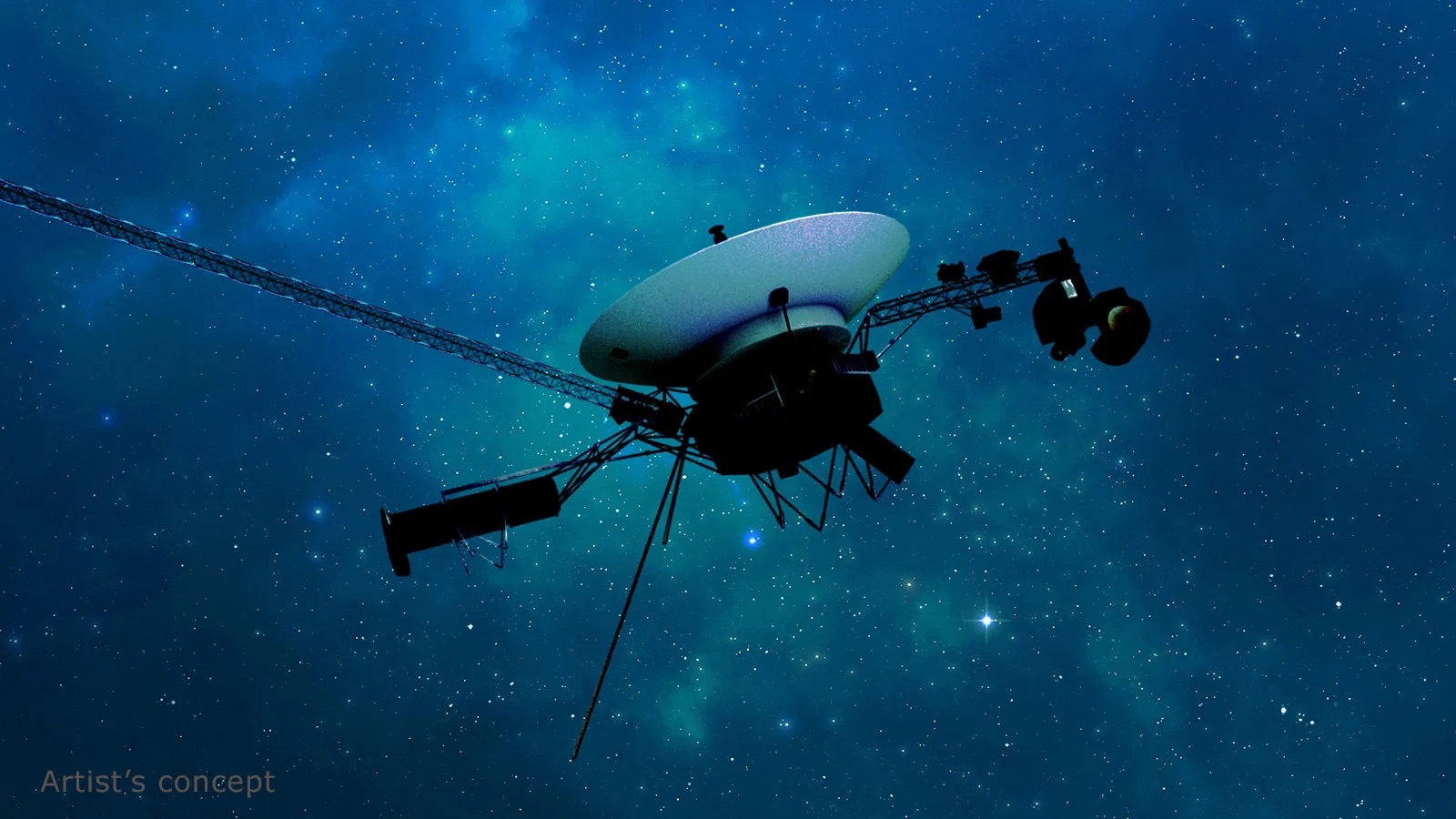
NASA’s Voyager Team Focuses on Software Patch, Thrusters

NASA Mission Update: Voyager 2 Communications Pause
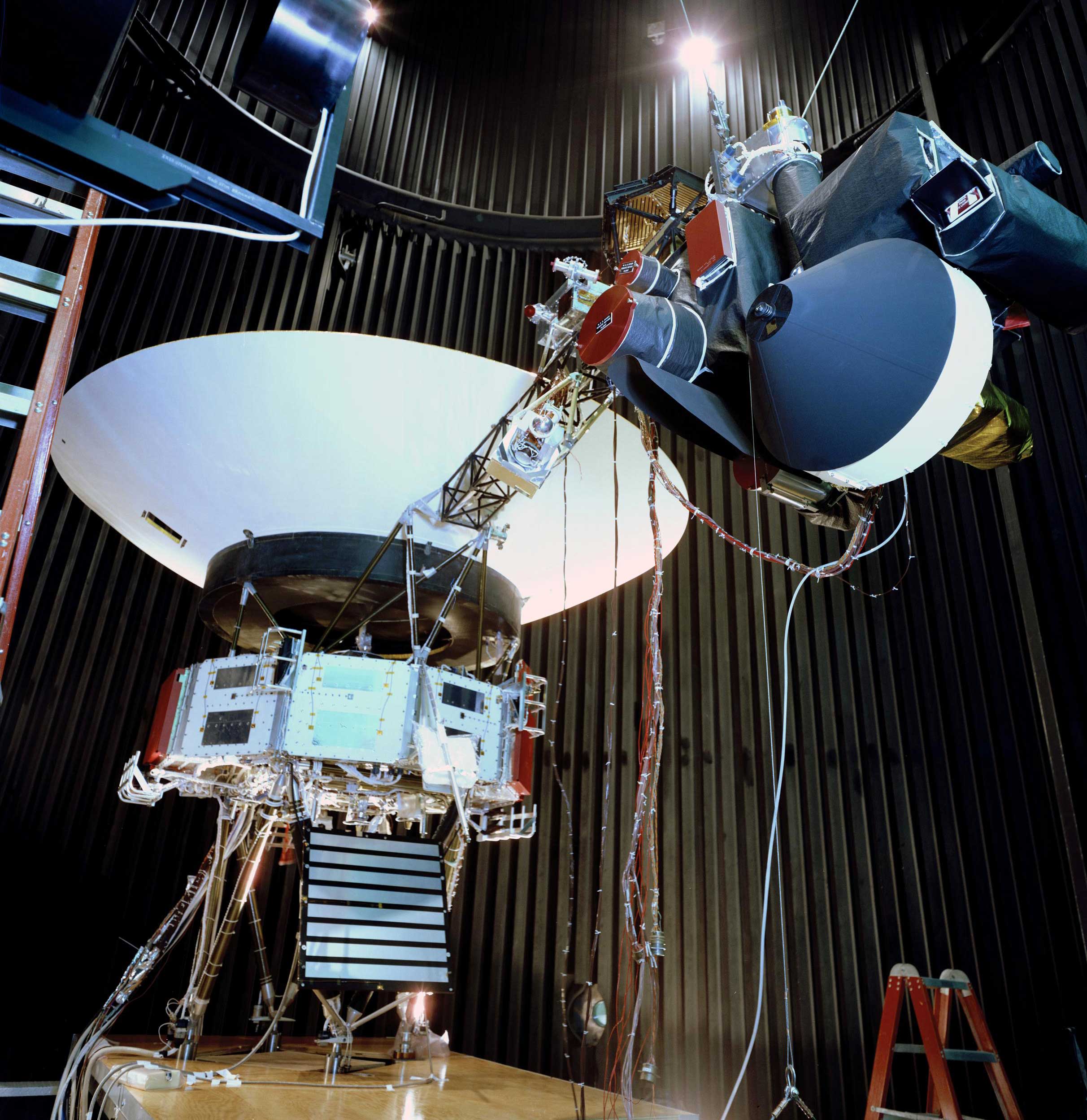
NASA's Voyager Will Do More Science With New Power Strategy
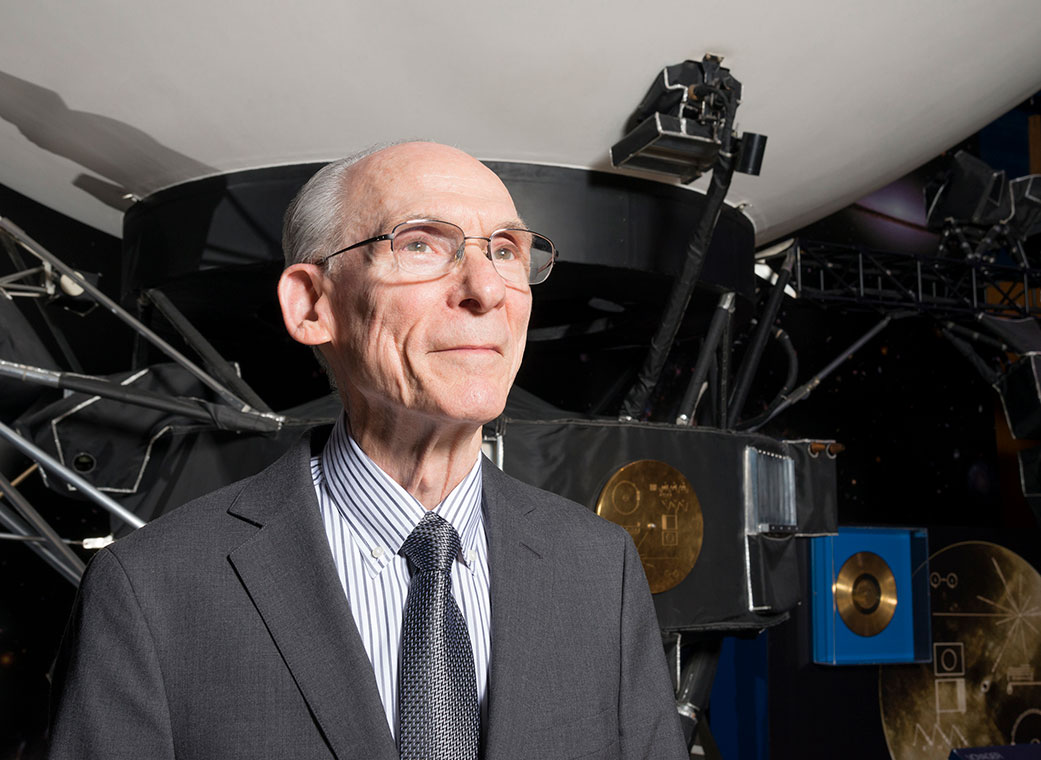
Edward Stone Retires After 50 Years as NASA Voyager's Project Scientist
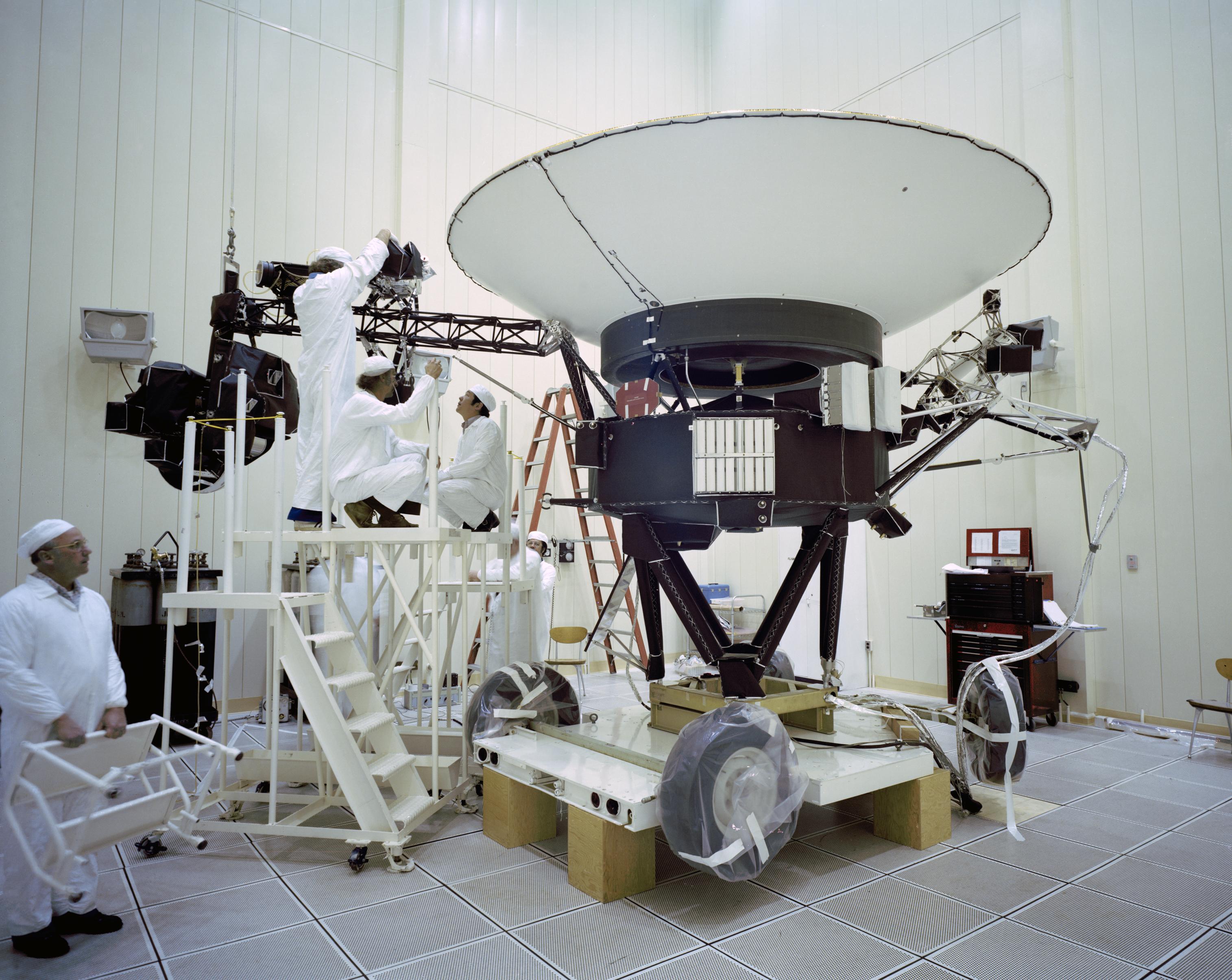
Voyager, NASA's Longest-Lived Mission, Logs 45 Years in Space
Voyager 1 distance from earth, voyager 1 distance from sun, voyager 1 one-way light time, voyager 1 cosmic ray data, voyager 2 distance from the earth, voyager 2 distance from the sun, voyager 2 one-way light time, voyager 2 cosmic ray data, what's happening now.
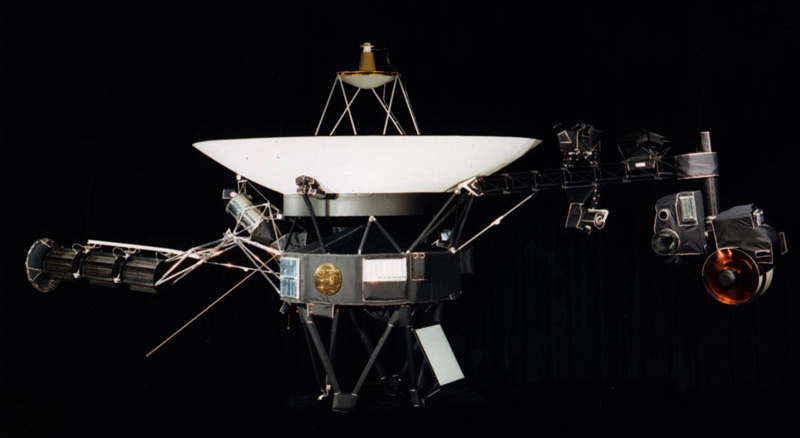
Since November 2023, NASA’s Voyager 1 spacecraft has been sending a steady radio signal to Earth, but the signal does not contain usable data.
Engineers are working to resolve an issue with one of Voyager 1’s three onboard computers, called the flight data system (FDS).
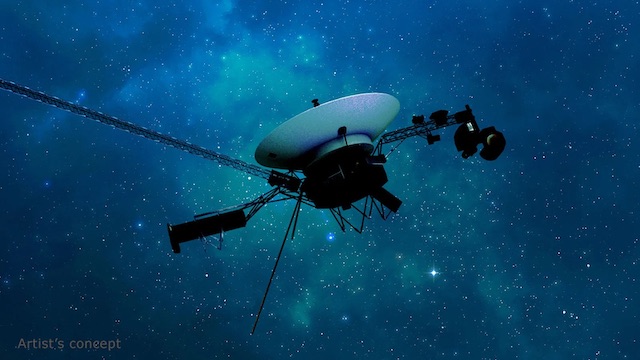
The efforts should help extend the lifetimes of the agency's interstellar explorers.

Download the Voyager 40th Anniversary posters.
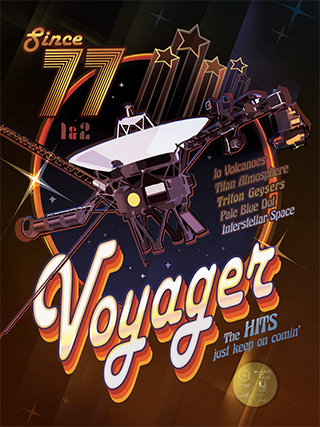
- More to Explore
- Series & Movies
Published Sep 13, 2013
Trek Stars with NASA's Voyager
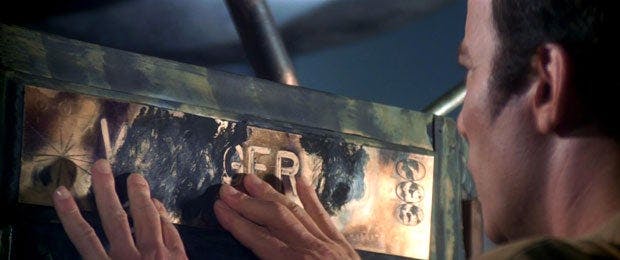
The line between science fiction and science fact – and more specifically between Star Trek and science fact -- is growing increasingly blurred. The latest case in point? NASA’s plutonium-powered Voyager 1 probe, launched in 1977, has gained the distinction of becoming the first manmade object to exit the solar system, a fact announced Thursday during a NASA press conference. Voyager – which actually departed the solar system last year; the data took a while to be received -- is now nearly 12 billion miles from Earth. And yes, it carries with a record player, and a golden record with songs by the likes of Bach, Louis Armstrong and Chuck Berry, as well as photographs and greetings in several languages.
During the press conference in Washington, NASA’s Dr. John Grunsfeld stepped to the podium accompanied by the Original Series theme music. He then proceeded to put a Voyager 1 spin on the iconic opening dialogue, saying: "Space: The final frontier. These are the voyages of the starship Voyager. Its 36-year mission… to explore strange new worlds, to seek out anomalous cosmic rays and new plasmas, to boldly go where no probe has gone before. Those words from Star Trek , of course, have inspired so many of us and I think are characteristic of the excitement and the discoveries we're going to talk about today. Voyager, like the ancient mariners, is pushing out into new territory… Someday humans will leave our cocoon in the solar system to explore beyond our home system. Voyager will have led the way."
Of course, the Star Trek -Voyager connection doesn’t end there. Star Trek: The Motion Picture featured a character named V’Ger. The sentient, creator-seeking entity was actually the Voyager 6, a fictitious 20th-century probe that disappeared into a black hole, where a race a living machines eventually breathed life into it. That set V'Ger on its destructive path and on to a date with destiny in the form of Kirk, Spock, McCoy, Ilia, etc. May Voyager 1… live long and prosper.
Get Updates By Email

Suggested Searches
- Climate Change
- Expedition 64
- Mars perseverance
- SpaceX Crew-2
- International Space Station
- View All Topics A-Z
Humans in Space
Earth & climate, the solar system, the universe, aeronautics, learning resources, news & events.

NASA/JAXA’s XRISM Mission Captures Unmatched Data With Just 36 Pixels

NASA Scientists Gear Up for Solar Storms at Mars

NASA Uses Small Engine to Enhance Sustainable Jet Research
- Search All NASA Missions
- A to Z List of Missions
- Upcoming Launches and Landings
- Spaceships and Rockets
- Communicating with Missions
- James Webb Space Telescope
- Hubble Space Telescope
- Why Go to Space
- Astronauts Home
- Commercial Space
- Destinations
- Living in Space
- Explore Earth Science
- Earth, Our Planet
- Earth Science in Action
- Earth Multimedia
- Earth Science Researchers
- Pluto & Dwarf Planets
- Asteroids, Comets & Meteors
- The Kuiper Belt
- The Oort Cloud
- Skywatching
- The Search for Life in the Universe
- Black Holes
- The Big Bang
- Dark Energy & Dark Matter
- Earth Science
- Planetary Science
- Astrophysics & Space Science
- The Sun & Heliophysics
- Biological & Physical Sciences
- Lunar Science
- Citizen Science
- Astromaterials
- Aeronautics Research
- Human Space Travel Research
- Science in the Air
- NASA Aircraft
- Flight Innovation
- Supersonic Flight
- Air Traffic Solutions
- Green Aviation Tech
- Drones & You
- Technology Transfer & Spinoffs
- Space Travel Technology
- Technology Living in Space
- Manufacturing and Materials
- Science Instruments
- For Kids and Students
- For Educators
- For Colleges and Universities
- For Professionals
- Science for Everyone
- Requests for Exhibits, Artifacts, or Speakers
- STEM Engagement at NASA
- NASA's Impacts
- Centers and Facilities
- Directorates
- Organizations
- People of NASA
- Internships
- Our History
- Doing Business with NASA
- Get Involved
- Aeronáutica
- Ciencias Terrestres
- Sistema Solar
- All NASA News
- Video Series on NASA+
- Newsletters
- Social Media
- Media Resources
- Upcoming Launches & Landings
- Virtual Events
- Sounds and Ringtones
- Interactives
- STEM Multimedia

NASA Balloons Head North of Arctic Circle for Long-Duration Flights

NASA’s Hubble Pauses Science Due to Gyro Issue

NASA’s Commercial Partners Deliver Cargo, Crew for Station Science

NASA Shares Lessons of Human Systems Integration with Industry

Work Underway on Large Cargo Landers for NASA’s Artemis Moon Missions

NASA-Led Study Provides New Global Accounting of Earth’s Rivers

NASA’s ORCA, AirHARP Projects Paved Way for PACE to Reach Space

Amendment 11: Physical Oceanography not solicited in ROSES-2024

Major Martian Milestones

Correction and Clarification of C.26 Rapid Mission Design Studies for Mars Sample Return

NASA’s Webb Maps Weather on Planet 280 Light-Years Away

Webb Captures Top of Iconic Horsehead Nebula in Unprecedented Detail

NASA Photographer Honored for Thrilling Inverted In-Flight Image

NASA’s Ingenuity Mars Helicopter Team Says Goodbye … for Now

Tech Today: Stay Safe with Battery Testing for Space

NASA Data Helps Beavers Build Back Streams

NASA Grant Brings Students at Underserved Institutions to the Stars

Washington State High Schooler Wins 2024 NASA Student Art Contest

NASA STEM Artemis Moon Trees

NASA’s Commitment to Safety Starts with its Culture

NASA Challenge Gives Space Thruster Commercial Boost

Diez maneras en que los estudiantes pueden prepararse para ser astronautas

Astronauta de la NASA Marcos Berríos

Resultados científicos revolucionarios en la estación espacial de 2023
Voyager, nasa’s longest-lived mission, logs 45 years in space, jet propulsion laboratory, beyond expectations, the long journey, more about the mission.
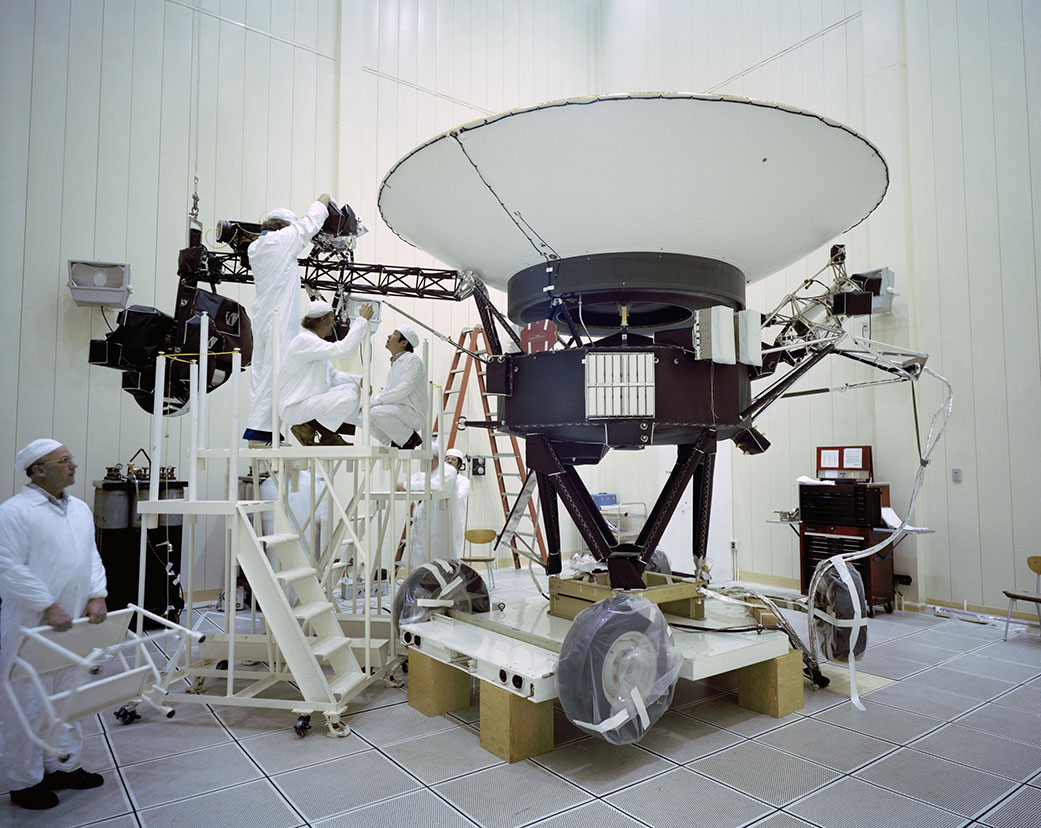
Launched in 1977, the twin Voyager probes are NASA’s longest-operating mission and the only spacecraft ever to explore interstellar space.
NASA’s twin Voyager probes have become, in some ways, time capsules of their era: They each carry an eight-track tape player for recording data, they have about 3 million times less memory than modern cellphones, and they transmit data about 38,000 times slower than a 5G internet connection.
Yet the Voyagers remain on the cutting edge of space exploration. Managed and operated by NASA’s Jet Propulsion Laboratory in Southern California, they are the only probes to ever explore interstellar space – the galactic ocean that our Sun and its planets travel through.
The Sun and the planets reside in the heliosphere, a protective bubble created by the Sun’s magnetic field and the outward flow of solar wind (charged particles from the Sun). Researchers – some of them younger than the two distant spacecraft – are combining Voyager’s observations with data from newer missions to get a more complete picture of our Sun and how the heliosphere interacts with interstellar space.
“The heliophysics mission fleet provides invaluable insights into our Sun, from understanding the corona or the outermost part of the Sun’s atmosphere, to examining the Sun’s impacts throughout the solar system, including here on Earth, in our atmosphere, and on into interstellar space,” said Nicola Fox, director of the Heliophysics Division at NASA Headquarters in Washington. “Over the last 45 years, the Voyager missions have been integral in providing this knowledge and have helped change our understanding of the Sun and its influence in ways no other spacecraft can.”
NASA’s Solar System Interactive lets users see where the Voyagers are right now relative to the planets, the Sun, and other spacecraft. Eyes on the Solar System . Credit: NASA/JPL-Caltech
The Voyagers are also ambassadors, each carrying a golden record containing images of life on Earth, diagrams of basic scientific principles, and audio that includes sounds from nature, greetings in multiple languages, and music. The gold-coated records serve as a cosmic “message in a bottle” for anyone who might encounter the space probes. At the rate gold decays in space and is eroded by cosmic radiation, the records will last more than a billion years.
Voyager 2 launched on Aug. 20, 1977, quickly followed by Voyager 1 on Sept. 5. Both probes traveled to Jupiter and Saturn, with Voyager 1 moving faster and reaching them first. Together, the probes unveiled much about the solar system’s two largest planets and their moons. Voyager 2 also became the first and only spacecraft to fly close to Uranus (in 1986) and Neptune (in 1989), offering humanity remarkable views of – and insights into – these distant worlds.
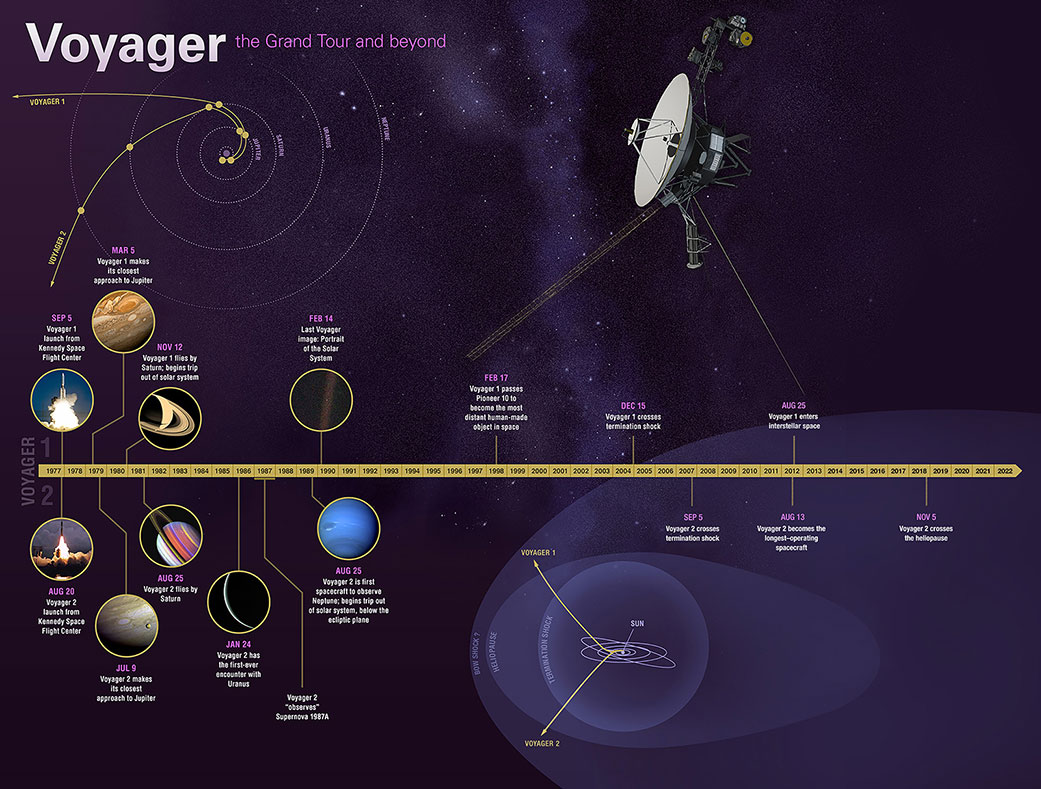
While Voyager 2 was conducting these flybys, Voyager 1 headed toward the boundary of the heliosphere. Upon exiting it in 2012 , Voyager 1 discovered that the heliosphere blocks 70% of cosmic rays, or energetic particles created by exploding stars. Voyager 2, after completing its planetary explorations, continued to the heliosphere boundary, exiting in 2018 . The twin spacecraft’s combined data from this region has challenged previous theories about the exact shape of the heliosphere.
“Today, as both Voyagers explore interstellar space, they are providing humanity with observations of uncharted territory,” said Linda Spilker, Voyager’s deputy project scientist at JPL. “This is the first time we’ve been able to directly study how a star, our Sun, interacts with the particles and magnetic fields outside our heliosphere, helping scientists understand the local neighborhood between the stars, upending some of the theories about this region, and providing key information for future missions.”
Over the years, the Voyager team has grown accustomed to surmounting challenges that come with operating such mature spacecraft, sometimes calling upon retired colleagues for their expertise or digging through documents written decades ago.
Each Voyager is powered by a radioisotope thermoelectric generator containing plutonium, which gives off heat that is converted to electricity. As the plutonium decays, the heat output decreases and the Voyagers lose electricity. To compensate , the team turned off all nonessential systems and some once considered essential, including heaters that protect the still-operating instruments from the frigid temperatures of space. All five of the instruments that have had their heaters turned off since 2019 are still working, despite being well below the lowest temperatures they were ever tested at.
Recently, Voyager 1 began experiencing an issue that caused status information about one of its onboard systems to become garbled. Despite this, the system and spacecraft otherwise continue to operate normally, suggesting the problem is with the production of the status data, not the system itself. The probe is still sending back science observations while the engineering team tries to fix the problem or find a way to work around it.
“The Voyagers have continued to make amazing discoveries, inspiring a new generation of scientists and engineers,” said Suzanne Dodd, project manager for Voyager at JPL. “We don’t know how long the mission will continue, but we can be sure that the spacecraft will provide even more scientific surprises as they travel farther away from the Earth.”
A division of Caltech in Pasadena, JPL built and operates the Voyager spacecraft. The Voyager missions are a part of the NASA Heliophysics System Observatory, sponsored by the Heliophysics Division of the Science Mission Directorate in Washington.
For more information about the Voyager spacecraft, visit:
https://www.nasa.gov/voyager
Calla Cofield Jet Propulsion Laboratory, Pasadena, Calif. 626-808-2469 [email protected]
NASA’s Voyager 1 Resumes Sending Engineering Updates to Earth

NASA’s Voyager 1 spacecraft is depicted in this artist’s concept traveling through interstellar space, or the space between stars, which it entered in 2012.
After some inventive sleuthing, the mission team can — for the first time in five months — check the health and status of the most distant human-made object in existence.
For the first time since November , NASA’s Voyager 1 spacecraft is returning usable data about the health and status of its onboard engineering systems. The next step is to enable the spacecraft to begin returning science data again. The probe and its twin, Voyager 2, are the only spacecraft to ever fly in interstellar space (the space between stars).
Voyager 1 stopped sending readable science and engineering data back to Earth on Nov. 14, 2023, even though mission controllers could tell the spacecraft was still receiving their commands and otherwise operating normally. In March, the Voyager engineering team at NASA’s Jet Propulsion Laboratory in Southern California confirmed that the issue was tied to one of the spacecraft’s three onboard computers, called the flight data subsystem (FDS). The FDS is responsible for packaging the science and engineering data before it’s sent to Earth.

After receiving data about the health and status of Voyager 1 for the first time in five months, members of the Voyager flight team celebrate in a conference room at NASA’s Jet Propulsion Laboratory on April 20.
The team discovered that a single chip responsible for storing a portion of the FDS memory — including some of the FDS computer’s software code — isn’t working. The loss of that code rendered the science and engineering data unusable. Unable to repair the chip, the team decided to place the affected code elsewhere in the FDS memory. But no single location is large enough to hold the section of code in its entirety.
So they devised a plan to divide the affected code into sections and store those sections in different places in the FDS. To make this plan work, they also needed to adjust those code sections to ensure, for example, that they all still function as a whole. Any references to the location of that code in other parts of the FDS memory needed to be updated as well.
The team started by singling out the code responsible for packaging the spacecraft’s engineering data. They sent it to its new location in the FDS memory on April 18. A radio signal takes about 22 ½ hours to reach Voyager 1, which is over 15 billion miles (24 billion kilometers) from Earth, and another 22 ½ hours for a signal to come back to Earth. When the mission flight team heard back from the spacecraft on April 20, they saw that the modification worked: For the first time in five months, they have been able to check the health and status of the spacecraft.
Get the Latest News from the Final Frontier
During the coming weeks, the team will relocate and adjust the other affected portions of the FDS software. These include the portions that will start returning science data.
Voyager 2 continues to operate normally. Launched over 46 years ago , the twin Voyager spacecraft are the longest-running and most distant spacecraft in history. Before the start of their interstellar exploration, both probes flew by Saturn and Jupiter, and Voyager 2 flew by Uranus and Neptune.
Caltech in Pasadena, California, manages JPL for NASA.
News Media Contact
Calla Cofield
Jet Propulsion Laboratory, Pasadena, Calif.
626-808-2469
The Untold Truth Of The Voyager Program
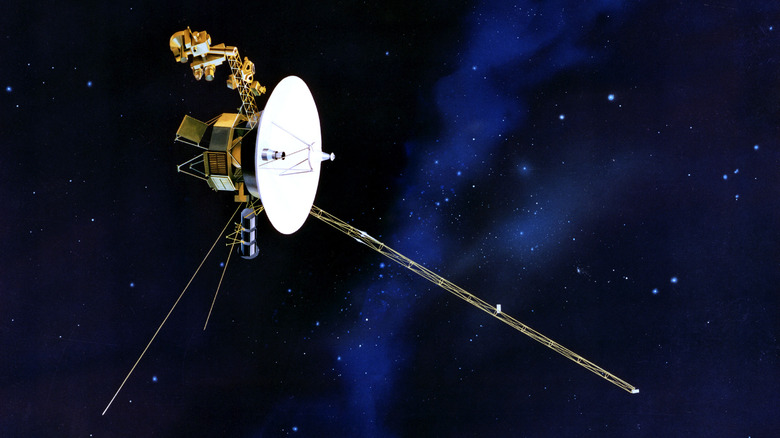
In 1979, Paramount Pictures released "Star Trek: The Motion Picture." In this first big-screen outing of the "Star Trek" franchise, IMDb tells us that the crew of the Enterprise face off against an enormous alien spacecraft called V'ger, a living machine. In the climax, it is discovered that V'ger is none other than Voyager 6, a probe from the famed 20th-century Voyager missions.
While in truth there was no Voyager 6, there indeed was and is a Voyager program. This program was born in the mid-20th-century space race , which NASA states culminated in the 1969 moon landing. While the moon landing was a major feat, it can be argued that we have learned more about our solar system and beyond through the Voyager program.
The concept of the mission was straightforward: Launch two spacecraft into our solar system to explore the outer planets. These probes left Earth in 1977, and not only did they achieve their mission, they have gone well beyond it, still transmitting data into the 2020s. Let's explore the details of the truth behind one of NASA's most successful space programs.
Voyager was only possible because of a 176-year phenomenon
The concept of the Voyager program was a natural addendum to the Mariner program. The Mariner space probes, as Britannica relates, were sent to the inner planets of our solar system — Mercury, Venus, and Mars — starting in 1962. Voyager was a similar concept, but its sights were set in the opposite direction. Yet the challenge here was the vast distance involved in reaching the outer planets. However, NASA's Jet Propulsion Laboratory tells us that in the summer of 1965, scientists had an epiphany. They found that once every 176 years, the giant planets of the outer solar system were aligned in such a way that it would be feasible to for a spacecraft to visit all of them by swinging from one to the other like a gymnast on the uneven bars. The secret to doing this was that the probes would be able to capitalize on the intense gravity of each planet to slingshot them on to the next. Futurism points out this trick allowed the Voyager probes to conserve precious fuel. It also greatly reduced the trip time. Without the gravity assist, a trip to Neptune could take 30 years; for Voyager, this dropped to 12. Thus, thanks to planetary alignment and more than a little gravity, NASA's Voyager program became a grand tour of the outer solar system.
There is no discernable difference between Voyager 1 and Voyager 2
For the grand tour, NASA designed two spacecraft: Voyager 1 and Voyager 2. One might assume that Voyager 2 is a more advanced vessel — like the numbers denoting a computer's operating system. However, according to NASA's Jet Propulsion Laboratory , the truth is that these two space probes are identical twins with all the same 65,000 parts .
The most prominent feature on the Voyagers are the over 12-foot-diameter radio dishes that transmit data to and receive commands from NASA . This dish is mounted on a nearly 6−foot-wide bus shaped like a decahedron. The Voyagers' other obvious features are three booms. There is an over 8−foot science boom that extends out from the spacecraft. This contains most of the scientific instruments for the mission, which include imaging equipment, particle detectors, and plasma sensors. More noticeable is Voyagers' second boom, a nearly 43−foot magnetometer. This instrument is used to measure changes in the magnetic field of the sun over distances, as well as to detect if the planets the probes were visiting had magnetic fields and, if so, how those planets' satellites interacted with them. The third boom extends out and contains the Radioisotope Thermoelectric Generators (RTG). These provide electrical power to keep the mission going. Both spacecraft are surprisingly light — both Voyager 1 and Voyager 2 weigh 1,592 pounds — but they are highly complex. It is remarkable that neither has experienced a major malfunction over the decades.
Voyager is powered by an extremely rare element
The Voyager probes were sent on a very long-distance trip with no place to refuel. NASA needed to find a power source that would allow the probes' RTGs to operate for decades. They found the answer in plutonium-238 oxide. Hearing the word "plutonium," one may think this is the same stuff that is used in nuclear weapons — think " Back to the Future ." However, the truth is that this variation of plutonium would not work well in either a missile or a nuclear power plant. Plutonium-238 emits alpha particles that heat the RTG's container, and that heat is then converted to electricity. Plutonium-238 has the virtues of having a long half life of 88 years, being stable despite high heat, and being able to generate more heat relative to its weight than other types of fuel. It also has a relatively low level of radiation, which is important since you don't want to have radiation interfere with Voyagers' instruments.
The element is also very rare. As the EPA explains, plutonium rarely exists in nature, and everything that NASA has is human-made. As for plutonium-238, production of the element has only been renewed in recent years, according to NASA. It is considered the only effective fuel for deep-space missions. For Voyager, this means an incredible fuel efficiency of 30,000 miles per gallon since most of its rocket fuel was burned right at launch.
Voyager 2 left before Voyager 1
By 1977, NASA was ready to launch Voyager 1 and Voyager 2. Curiously, the space agency launched Voyager 2 first on August 20. Voyager 1 followed about two weeks later on September 5. To get the probes into space, NASA perched them atop expendable Titan-Centaur rockets. The Air and Space Museum notes that in truth, each Titan-Centaur unit consisted of multiple rockets that fired in stages to overcome Earth's gravity and operated with a mix of liquid and solid fuel. At the time of the "flawless" launch of Voyager 1, The New York Times commented that scientists expected that the Voyager spacecraft could last for 30 years. These scientists underestimated their own spacecraft.
Even though Voyager 2 launched first, Voyager 1 traveled faster using a shorter trajectory. It was still a long journey. Voyager 1 arrived at Jupiter on March 5, 1979, and Voyager 2 on July 9 of that year.
Voyager gave us our first close-ups of the gas giants
What NASA originally had planned for the Voyager spacecraft was an exploration trip to Jupiter and Saturn. This was highly successful. In its flyby of Jupiter, Voyager 1 also examined several of its moons and made strange discoveries, such as the intense volcanism on the moon Io, as well as finding two new moons. Using a camera that could make out a newspaper headline at .62 miles, it sent back photographs of the landscapes of these moons and opened up new paths in planetary science. Similar discoveries were made when the spacecraft reached Saturn in November 1979, where it found new moons and made a detailed study of Saturn's ring system. Voyager 2 was equally successful and made even closer approaches than Voyager 1. In fact, Voyager 2 flew through Saturn's rings at 8 miles per second, during which time thousands of tiny dust fragments bombarded the spacecraft, forcing it to use its attitude control thrusters to keep it on course. Curiously, Voyagers' thrusters are not exactly like the thrusters on, say, a Battlestar Galactica Viper . NASA's Jet Propulsion Laboratory tells us that a Voyager thruster only provides a thrust of 3 ounces. While this is okay in frictionless space, if a large car were using these thrusters to accelerate on a flat road, NASA says it would take 6 hours to reach a speed of 30 miles per hour.
Voyager 1 and 2 have separate fates
After Saturn, the twin spacecraft went on to different destinies. The Planetary Society recounts how Voyager 1 veered off of the plane of the solar system and headed for interstellar space. Voyager 2, however, headed toward the deepest planets of the solar system. It reached Uranus in January 1986 , where it discovered two unknown rings and 11 moons. As NASA's Jet Propulsion Laboratory describes, Neptune was equally fruitful, with amazing data and images. After reaching it in 1989, Voyager 2 came within 3,000 miles of this planet, discovering six unknown moons and four rings.
The truth is that there were particular challenges with Neptune. NASA explains that this planet is 30 times farther away from the sun than Earth. As a result, the light is faint. In order to get images, Voyager 2 had to use long exposure times for its cameras. However, since the probe was moving so fast (about 60,000 mph at the time), NASA had to direct the spacecraft to fire its thrusters to coax the probe's cameras to stay focused on the planet while not altering its course.
After Neptune, Voyager 2 joined Voyager 1 in heading to interstellar space. The Planetary Society says that Voyager 1 reached the heliopause, the point where the solar wind ceases, in August 2012. Voyager 2 entered it in November 2018. This showed scientists about where the solar system ends and also provided information on what makes up interstellar space.
Voyager went well beyond its mission
Perhaps what is most remarkable about the Voyager program is the endurance of these spacecraft. Much of the credit for this goes to the clever NASA scientists and engineers who figured out ways to keep the little probes chugging along. Universe Today notes that to deal with inevitable energy loss, systems have been shut down one by one. Sometimes things work out better than expected. In 2011, NASA shut off the heater for Voyager 1's ultraviolet spectrometer to conserve fuel. The instrument was designed to operate down to minus 31 degrees F, but they found that it kept working down to minus 110 degrees F. Similarly, they found that the Cosmic Ray Subsystem will operate at temperatures of minus 74 degrees F, although they were tested only down to minus 49 degrees F. In 2017, NASA noticed a problem with one of Voyager 1's thrusters, which needed to operate properly to orient its dish toward Earth. They started up a secondary thruster which had not been operated for 37 years. Amazingly, it worked fine. Suzanne Dodd, the Voyager Project Manager with NASA's Jet Propulsion Laboratory , stated, "It's incredible that Voyagers' instruments have proved so hardy."
Both Voyager 1 and 2 are still active, with NASA reporting their status in real time. Inevitably, the Voyagers will run out of fuel and cease communication with us on Earth. The Jet Propulsion Laboratory estimates that they will function until at least 2025. However, both of these spacecraft carry a message from us to others who may be among the stars.

Voyager's golden records highlight whale song
Even though the Voyager probes' signals to us will eventually fade to nothing, the spacecraft will continue to travel through space indefinitely. The Jet Propulsion Laboratory estimates that with their current course and speed, they will approach neighboring stars in about 40,000 years. This is why each Voyager carries a golden record. As reported by Smithsonian Magazine , the record is the brainchild of astronomers Carl Sagan and Frank Drake. They had already sent on the Pioneer 10 and 11 spacecraft gold-anodized aluminum plaques that featured etched images of a man and woman with directions to Earth. Hopefully, if any alien race found these plaques, they would come in peace.
The records carried by the Voyagers, however, are different since they contain the sounds and sights of Earth. On it are 115 encoded photographs, 90 minutes of music, salutations in 55 languages, and 12 minutes of Earth sounds. Some information is human-specific, such as showing human reproductive anatomy as well as the structure of our DNA. They also show humans eating and drinking and include excerpts from Euclid and Isaac Newton. Animal sounds were added as well, including a haunting whale song. It is assumed that if any extraterrestrial civilization finds the golden records, they will have the technology to decode them. Whether it would make sense to them remains to be seen.
Voyager is not the fastest, but the farthest
Because of the gravity-assisted slingshot effect the Voyagers received during their mission, they have built up to an incredible speed. NASA 's current mission status shows Voyager 1 traveling in excess of 38,000 miles per hour while Voyager 2 is cruising along at a not-too-shabby 34,000 miles per hour. This makes them among the fastest-traveling human-made space objects out there.
However, it is necessary to put this into perspective since there are some probes out there that have achieved many times the speed of the Voyager spacecraft. The current record holder is the Parker Solar Probe. CNET reported that in 2021, this spacecraft achieved an unfathomable speed of 330,000 miles per hour after it slingshotted around Venus and entered a close orbit with the sun. So while Voyager wouldn't get the gold medal in a 100-meter dash, it would win a marathon. At over 14 billion and 12 billion miles away from Earth respectively, Voyagers 1 and 2 are the most distant human-made objects from Earth, according to Earth Sky . Keep in mind, however, that in the grand scheme of things, 14 billion miles is peanuts. To get to even a close star, NASA says it will take millennia upon millennia. For example, in 296,000 thousand years, Voyager 2 will get within 4.3 light years of Sirius, the brightest star out there.
Only one place on Earth can communicate with Voyager 2
Considering the growing distance that separates the Voyager spacecraft from Earth, communications have been a challenge that has only grown more complicated through the years. In 2022, NASA noted that it takes over 20 and a half hours to send a signal to Voyager 1. In its primer on Voyager communications, How Stuff Works explains that the probes use 23-watt radios, which on the whole are not nearly as powerful as, say, a commercial radio station, which transmits at tens of thousands of watts. To do the job, Voyager and Earth point their signals directly at each other and use very large antennas. What is more, communications are sent at 8 GHz — a rarely used frequency — thus there is less interference. With all these specific requirements, it is little wonder that, according to NASA , there is only one place remaining on the globe that can communicate with Voyager 2: Deep Space Station 43 (DSS43). This station, which is in Canberra, Australia, is part of the Deep Space Network, an assortment of antennas around the world that communicates with spacecraft beyond the moon. In order to improve its deep-space communication abilities, DSS43's antenna was upgraded to a 230-foot-wide dish in 1987.
The Voyager program has a great return on investment
The Voyager program is perhaps one of the single best returns on investment in the history of NASA . From the time work started on it in 1972 until its encounter with Neptune, Voyager cost $865 million dollars. This figure includes all ancillary communication support. NASA points out that this figure would mean a burden of 8 cents per U.S. resident per year. This is not to say that Voyager was cheaply done. NASA put in 11,000 work years on the project until the Neptune flyby, which they compare as being one third of the amount of effort expended on constructing the Great Pyramid.
The truth is that stacking up the Voyager program to a world wonder is an apt comparison. The amount of data and information that we have received (five trillion bits worth) has expanded our horizons (literally) and knowledge of ourselves and our small planet's place in the universe.
Voyager may outlast humanity
If you were to make a bet on which will last longer, Voyager or humankind, the odds may just favor Voyager. Space.com considers the mission's longevity. It notes that one projection shows that with the spacecraft's current trajectory, after some 500 million years, the probes will have completed an orbit of the Milky Way . By this time, Voyager 1 will be above the plane of the galaxy, which means that it will see fewer stars than Voyager 2 since it will be in a much less dense region.
The greatest danger to the Voyagers is space dust, which, when moving at several miles per second, could flay away the skin of the spacecraft like a cosmic sandblaster. It is unlikely that the Voyagers will get close enough to a star to truly endanger them for billions of years. In fact, it may be an as-yet unborn star that finally takes out one of these dogged spacecraft. So while its far-future course is hard to predict, it may be that Voyager 1 and 2 will at least be flying at the time that the Andromeda galaxy collides with the Milky Way, which will be in five billion years, according to Earth Sky . And if all goes well, Voyagers' golden records could theoretically last just as long – longer than life on Earth , in fact. In this way, the Voyagers would become eternal artifacts of a human civilization that once existed on a small blue world.

- April 24, 2024 | Shedding Pounds, Dodging Cancer: The Life-Saving Promise of Bariatric Surgery
- April 24, 2024 | Quantum Computing Meets Genomics: The Dawn of Hyper-Fast DNA Analysis
- April 24, 2024 | Scientists Turn to Venus in the Search for Alien Life
- April 24, 2024 | NASA Astronauts Enter Quarantine As Boeing Starliner Test Flight Approaches
- April 23, 2024 | Peeking Inside Protons: Supercomputers Reveal Quark Secrets
NASA’s Longest-Lived Mission: Voyager Probes Log 45 Years in Space
By Jet Propulsion Laboratory August 19, 2022
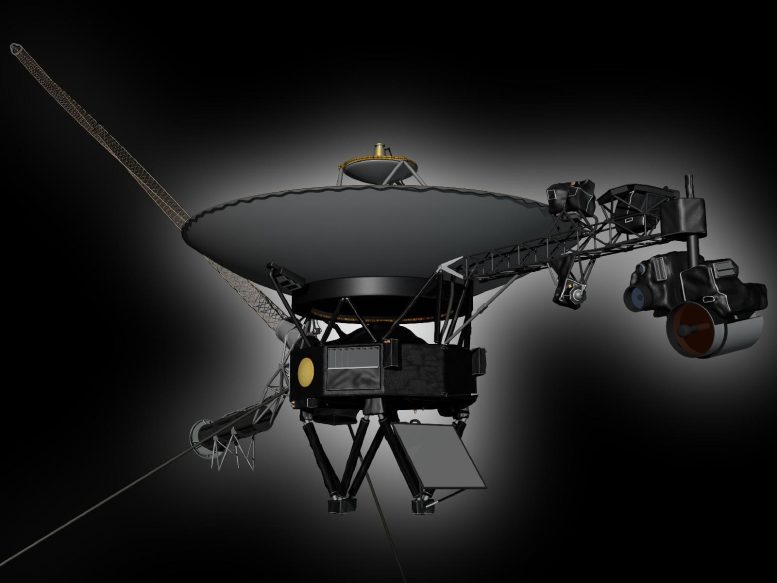
This artist’s rendering shows NASA’s Voyager spacecraft. On the boom to the right, the Cosmic Ray Science instrument, Low Energy Charged Particle detector, the Infrared Spectrometer and Radiometer, Ultraviolet Spectrometer, Photopolarimeter and Wide and Narrow Angle Cameras are visible. The bright gray square is an optical calibration plate for the instruments. The Golden Record, containing images and sounds from Earth, is the yellow circle on the main spacecraft body. The dish is the spacecraft’s high-gain antenna for communications with Earth. The magnetometer boom stretches out to the upper left. The radio isotope thermoelectric generators, Voyager’s power source, are visible to the lower left. The two long thin rods extending out to the left are antennas used by the Plasma Wave instrument. The Planetary Radio instrument also used these antennas when it was turned on. Credit: NASA/JPL-Caltech
Launched in 1977, the twin Voyager probes are NASA ’s longest-operating mission and the only spacecraft ever to explore interstellar space.
Launched in 1977, NASA’s twin Voyager spacecraft inspired the world with pioneering visits to Jupiter , Saturn , Uranus , and Neptune . Their journey continues 45 years later as both probes explore interstellar space, the region outside the protective heliosphere created by our Sun. Researchers – some younger than the spacecraft – are now using Voyager data to solve mysteries of our solar system and beyond.
NASA’s twin Voyager probes have become, in many ways, time capsules of their era: They each carry an eight-track tape player for recording data, they transmit data about 38,000 times slower than a 5G internet connection, and they have about 3 million times less memory than modern cellphones.
Despite this, the Voyagers remain on the cutting edge of space exploration. Managed and operated by NASA’s Jet Propulsion Laboratory ( JPL ) in Southern California, they are the only probes to ever explore interstellar space – the galactic ocean that our Sun and its planets travel through.
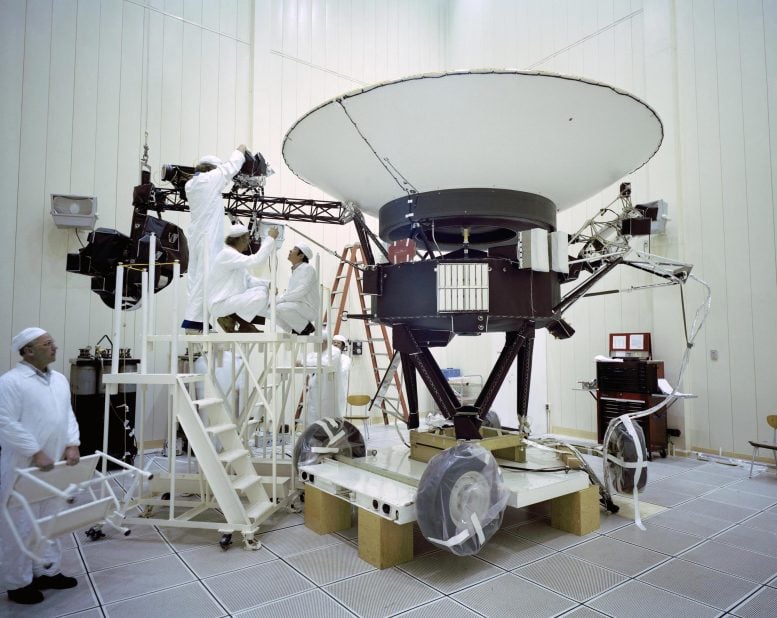
This archival image taken at NASA’s Jet Propulsion Laboratory on March 23, 1977, shows engineers preparing the Voyager 2 spacecraft ahead of its launch later that year. Credit: NASA/JPL-Caltech
The Sun and the planets reside in the heliosphere, a protective bubble created by the Sun’s magnetic field and the outward flow of solar wind (charged particles from the Sun). Scientists – some of them younger than the two distant spacecraft – are combining Voyager’s observations with data from newer missions to get a more complete picture of our Sun and how the heliosphere interacts with interstellar space.
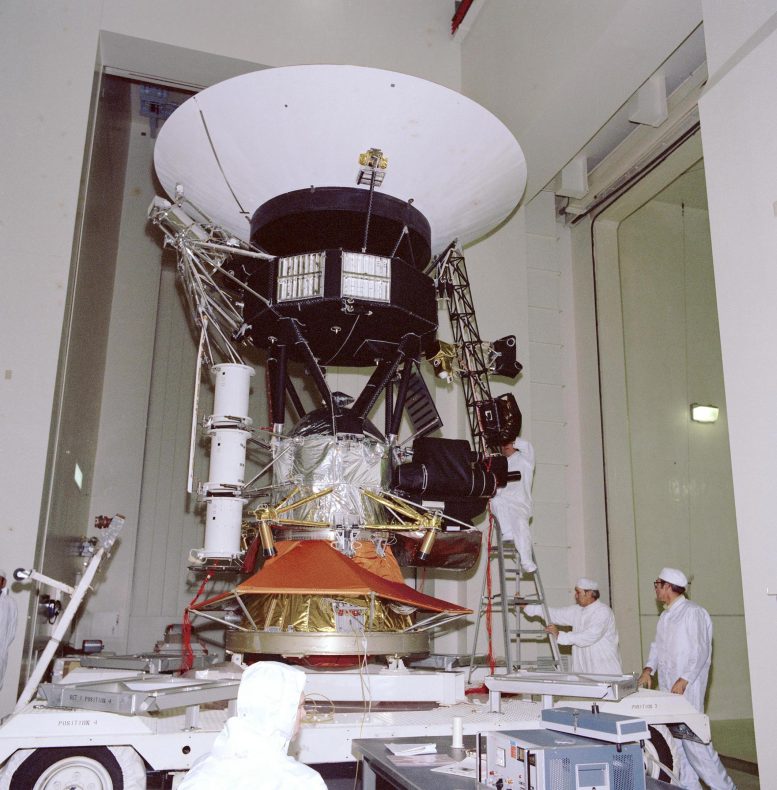
This archival photo shows engineers working on vibration acoustics and pyro shock testing of NASA’s Voyager on November 18, 1976. Credit: NASA/JPL-Caltech
“The heliophysics mission fleet provides invaluable insights into our Sun, from understanding the corona or the outermost part of the Sun’s atmosphere, to examining the Sun’s impacts throughout the solar system, including here on Earth, in our atmosphere, and on into interstellar space,” said Nicola Fox, director of the Heliophysics Division at NASA Headquarters in Washington. “Over the last 45 years, the Voyager missions have been integral in providing this knowledge and have helped change our understanding of the Sun and its influence in ways no other spacecraft can.”
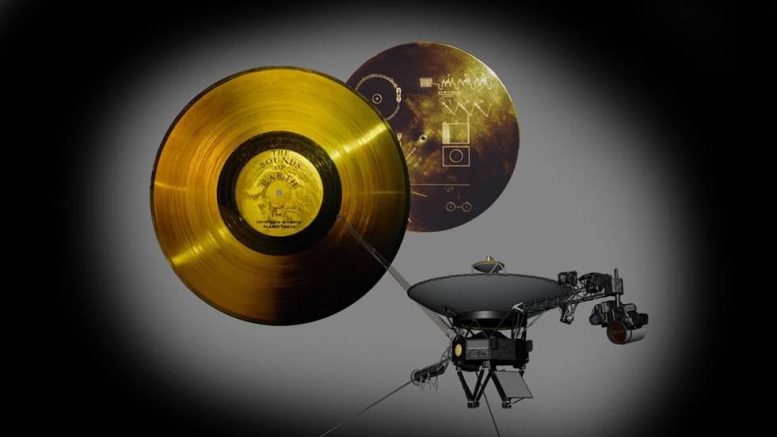
This image highlights the special cargo onboard NASA’s Voyager spacecraft: the Golden Record. Each of the two Voyager spacecraft launched in 1977 carry a 12-inch gold-plated phonograph record with images and sounds from Earth. Credit: NASA/JPL-Caltech
The Voyagers are also ambassadors for humanity, each carrying a golden record containing images of life on Earth, diagrams of basic scientific principles, and audio that includes sounds from nature, greetings in multiple languages, and music. The gold-coated records serve as a cosmic “message in a bottle” for anyone who might encounter the space probes. At the rate gold decays in space and is eroded by cosmic radiation, the records will last more than a billion years.
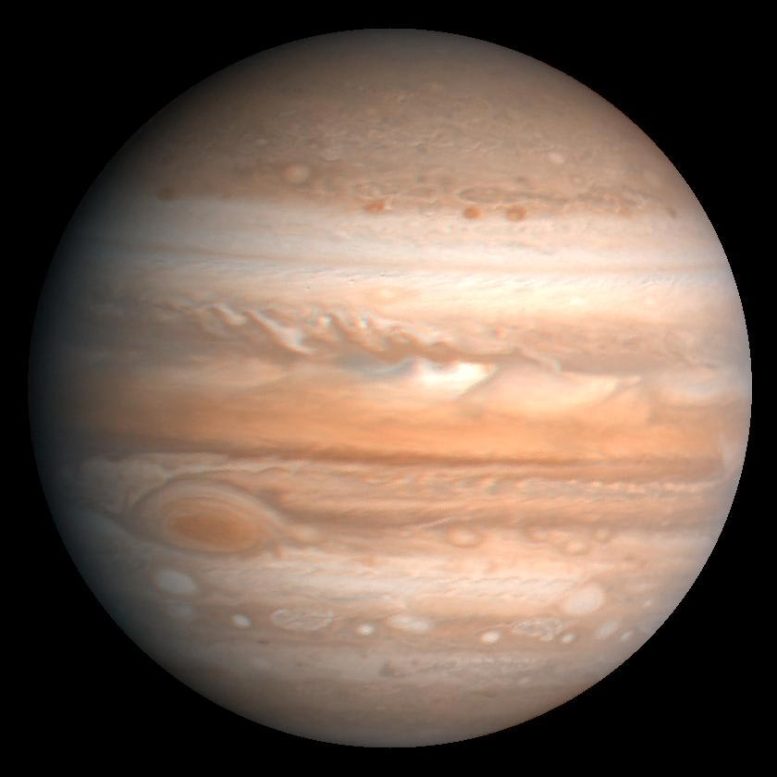
This processed color image of Jupiter was produced in 1990 by the U.S. Geological Survey from a Voyager image captured in 1979. Zones of light-colored, ascending clouds alternate with bands of dark, descending clouds. Credit: NASA/JPL/USGS
Beyond Expectations
Voyager 2 launched on August 20, 1977, quickly followed by Voyager 1 on September 5. Both probes traveled to Jupiter and Saturn , with Voyager 1 moving faster and reaching them first. Together, the probes unveiled much about the solar system’s two largest planets and their moons. Voyager 2 also became the first and only spacecraft to fly close to Uranus (in 1986) and Neptune (in 1989), offering humanity remarkable views of – and insights into – these distant worlds.
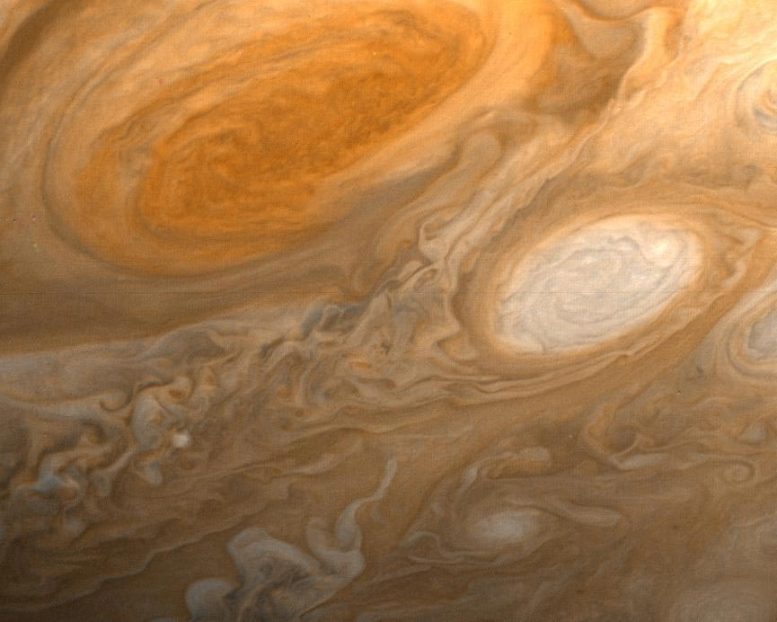
This photo of Jupiter was taken by NASA’s Voyager 1 on the evening of March 1, 1979, from a distance of 2.7 million miles (4.3 million kilometers). The photo shows Jupiter’s Great Red Spot (top) and one of the white ovals. Credit: NASA/JPL
While Voyager 2 was conducting these flybys, Voyager 1 headed toward the boundary of the heliosphere. Upon exiting it in 2012 , Voyager 1 discovered that the heliosphere blocks 70% of cosmic rays, or energetic particles created by exploding stars. Voyager 2, after completing its planetary explorations, continued to the heliosphere boundary, exiting in 2018 . The twin spacecraft’s combined data from this region has challenged previous theories about the exact shape of the heliosphere.
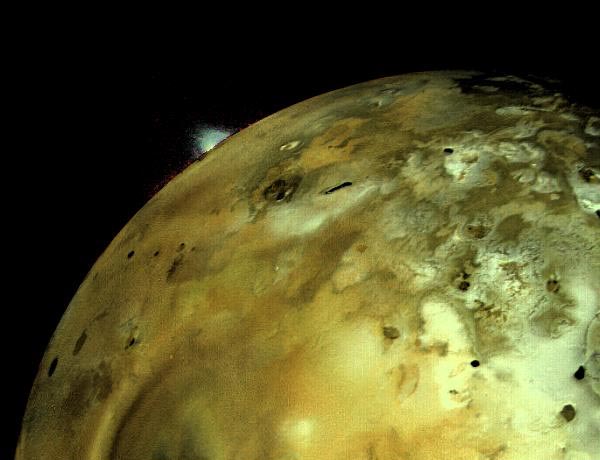
NASA’s Voyager 1 acquired this image of a volcanic explosion on Io on March 4, 1979, about 11 hours before the spacecraft’s closest approach to the moon of Jupiter. Credit: NASA/JPL
“Today, as both Voyagers explore interstellar space, they are providing humanity with observations of uncharted territory,” said Linda Spilker, Voyager’s deputy project scientist at JPL. “This is the first time we’ve been able to directly study how a star, our Sun, interacts with the particles and magnetic fields outside our heliosphere, helping scientists understand the local neighborhood between the stars, upending some of the theories about this region, and providing key information for future missions.”
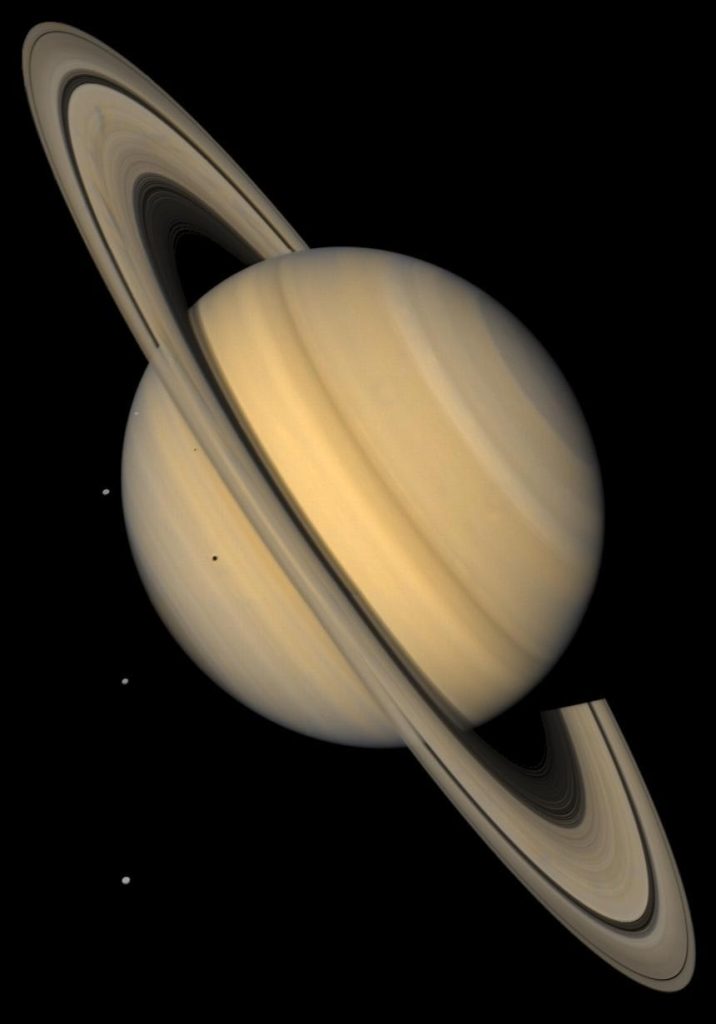
This approximate natural-color image from NASA’s Voyager 2 shows Saturn, its rings, and four of its icy satellites. Three satellites Tethys, Dione, and Rhea are visible against the darkness of space. Credit: NASA/JPL/USGS
The Long Journey
Over the years, the Voyager team has grown accustomed to surmounting challenges that come with operating such mature spacecraft, sometimes calling upon retired colleagues for their expertise or digging through documents written decades ago.
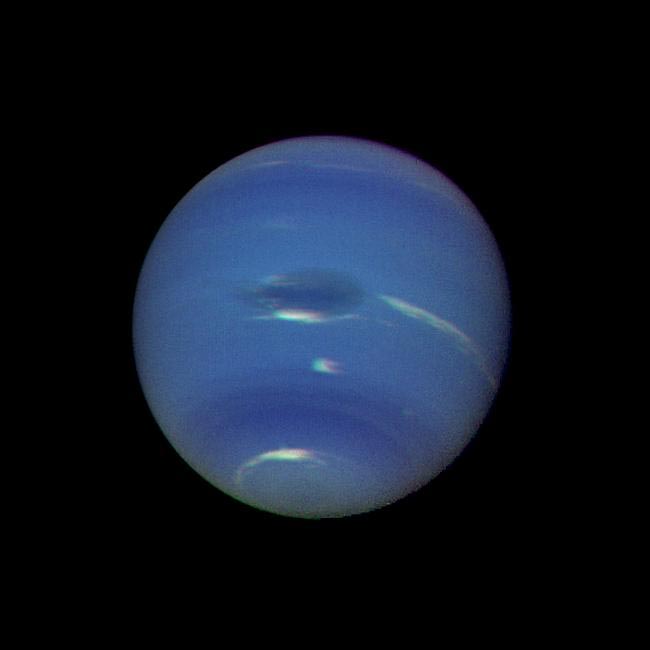
Neptune’s green-blue atmosphere was shown in greater detail than ever before in this image from NASA’s Voyager 2 as the spacecraft rapidly approached its encounter with the giant planet in August 1989. Credit: NASA/JPL
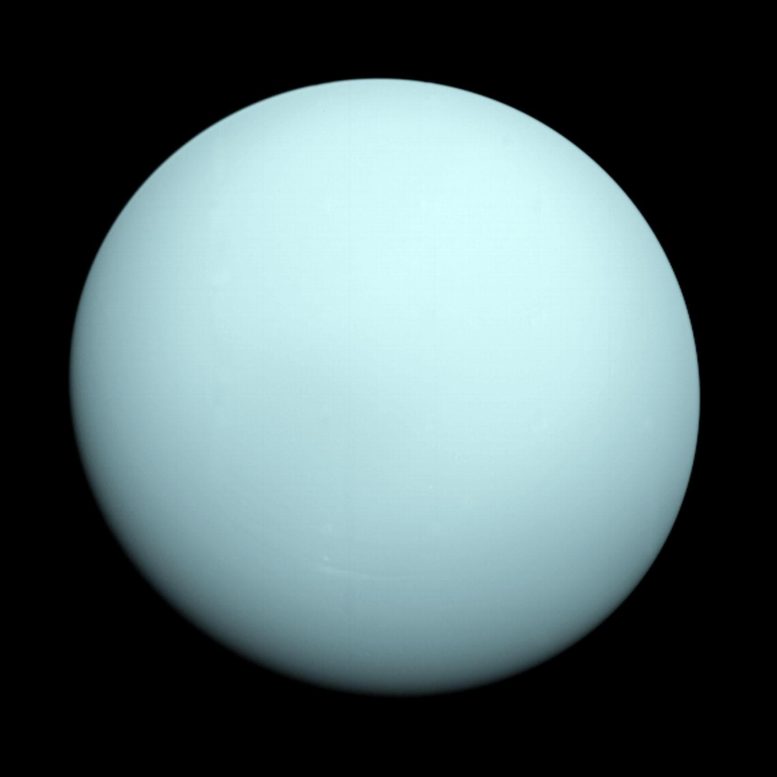
This is an image of the planet Uranus taken by the spacecraft Voyager 2 in 1986. Credit: NASA/JPL-Caltech
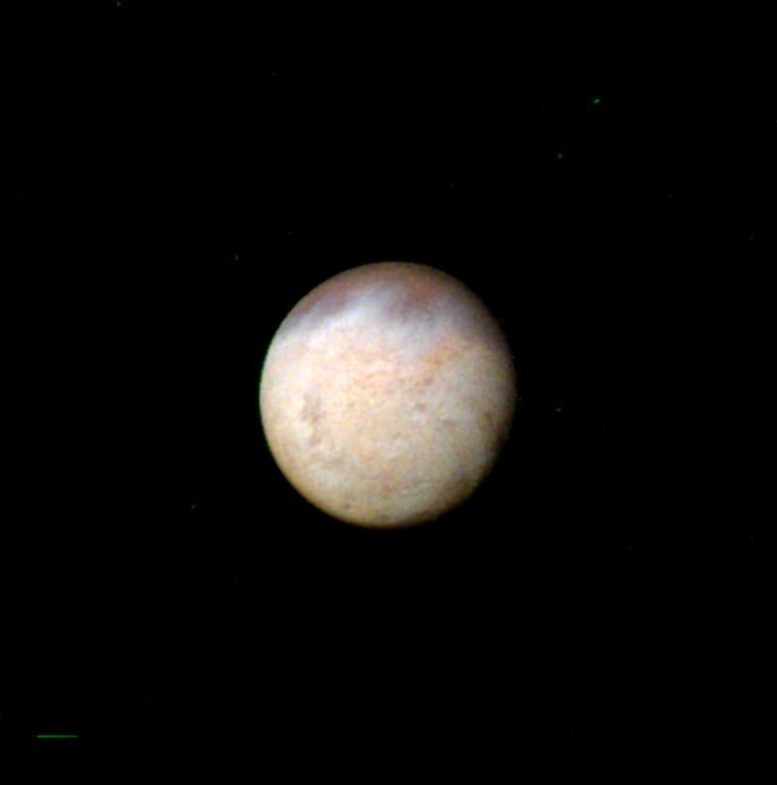
This image, taken by NASA’s Voyager 2 early in the morning of August 23, 1989, is a false color image of Triton, Neptune’s largest satellite; mottling in the bright southern hemisphere is present. Credit: NASA/JPL
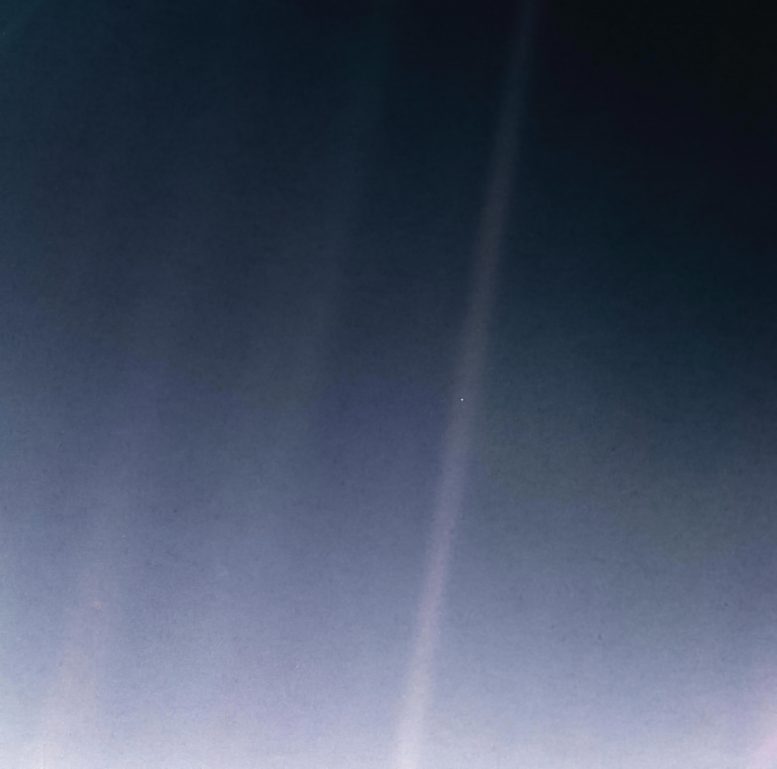
This updated version of the iconic “Pale Blue Dot” image taken by the Voyager 1 spacecraft uses modern image-processing software and techniques to revisit the well-known Voyager view while attempting to respect the original data and intent of those who planned the images. Credit: NASA/JPL-Caltech
Each Voyager is powered by a radioisotope thermoelectric generator containing plutonium, which gives off heat that is converted to electricity. As the plutonium decays, the heat output decreases and the Voyagers lose electricity. To compensate , the team turned off all nonessential systems and some once considered essential, including heaters that protect the still-operating instruments from the frigid temperatures of space. All five of the instruments that have had their heaters turned off since 2019 are still working, despite being well below the lowest temperatures they were ever tested at.
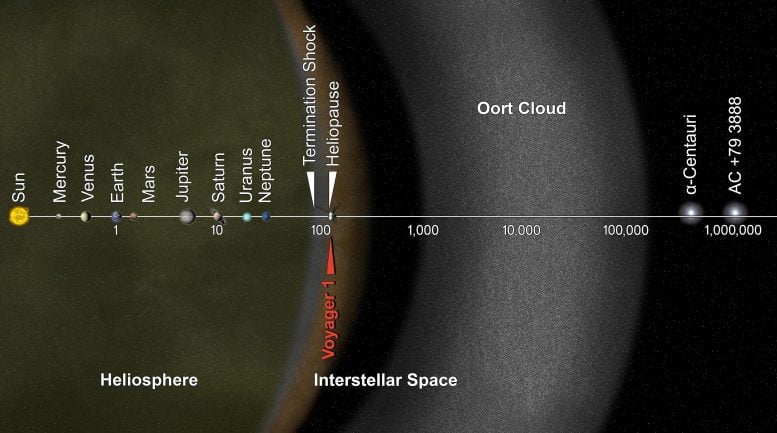
This illustrated graphic was made to mark Voyager 1’s entry into interstellar space in 2012. It puts solar system distances in perspective, with the scale bar in astronomical units and each set distance beyond 1 AU (the average distance between the Sun and Earth) representing 10 times the previous distance. Credit: NASA/JPL-Caltech
Recently, Voyager 1 began experiencing an issue that caused status information about one of its onboard systems to become garbled. Despite this, the system and spacecraft otherwise continue to operate normally, suggesting the problem is with the production of the status data, not the system itself. The probe is still sending back science observations while the engineering team tries to fix the problem or find a way to work around it.
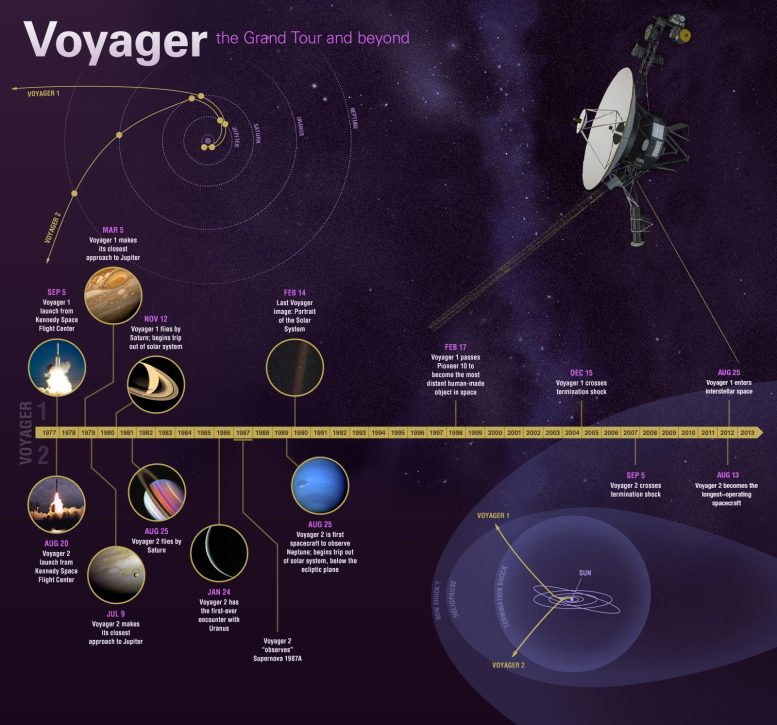
This graphic highlights some of the Voyager mission’s key accomplishments. Credit: NASA/JPL-Caltech
“The Voyagers have continued to make amazing discoveries, inspiring a new generation of scientists and engineers,” said Suzanne Dodd, project manager for Voyager at JPL. “We don’t know how long the mission will continue, but we can be sure that the spacecraft will provide even more scientific surprises as they travel farther away from the Earth.”
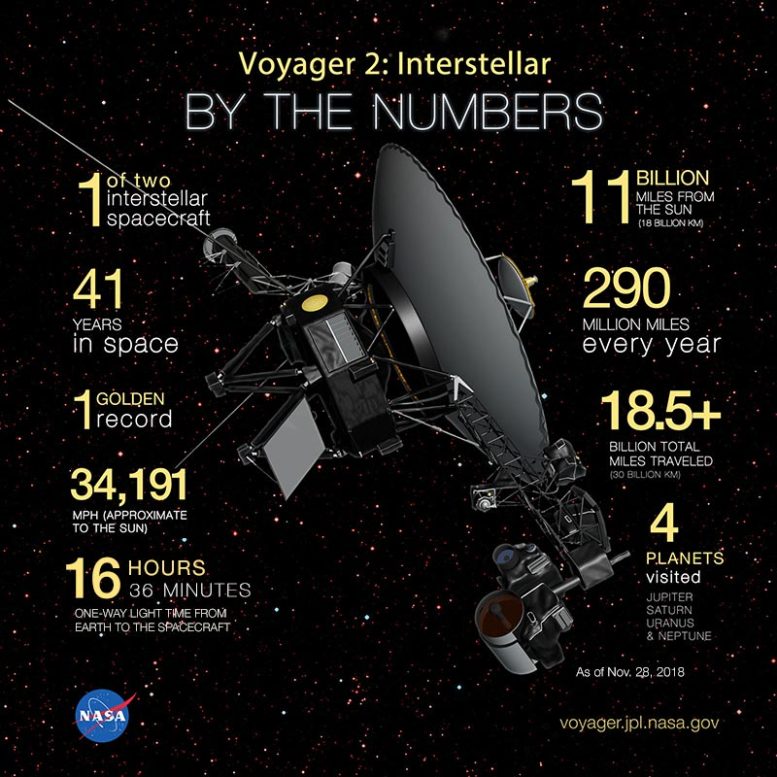
This graphic provides some of the mission’s key statistics from 2018, when NASA’s Voyager 2 probe exited the heliosphere. Credit: NASA/JPL-Caltech
More About the Mission
A division of Caltech in Pasadena, JPL built and operates the Voyager spacecraft. The Voyager missions are a part of the NASA Heliophysics System Observatory, sponsored by the Heliophysics Division of the Science Mission Directorate in Washington.
More on SciTechDaily
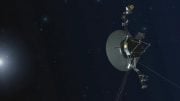
Voyager 2 Illuminates Boundary of Interstellar Space 11 Billion Miles From Earth
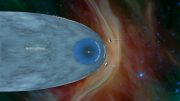
Voyager 2 Probe Enters Interstellar Space, Over 18 Billion Kilometers from Earth
Mysteries abound: nasa studying the edge of the sun’s magnetic bubble.

It’s Official – Voyager 1 Has Entered Interstellar Space
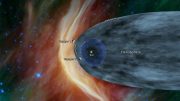
Hear the Eerie Sounds of Interstellar Space Captured by NASA’s Voyager
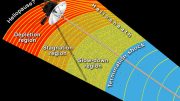
NASA’s Voyager 1 Explores the Outer Limits of Our Heliosphere
Nasa’s interstellar boundary explorer charts 11 years of change to heliosphere.
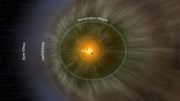
IBEX Reveals How Solar Wind Changes Our Heliosphere
9 comments on "nasa’s longest-lived mission: voyager probes log 45 years in space".
How is information transmitted from Voyager back to Earth and vice versa? WiFi? I want WiFi that strong for my house. Serious question.
“The uplink communications are executed via S-band microwave communications. The downlink communications are carried out by an X-band microwave transmitter on board the spacecraft, with an S-band transmitter as a back-up. All long-range communications to and from the two Voyagers have been carried out using their 3.7-meter (12 ft) high-gain antennas. The high-gain antenna has a beamwidth of 0.5° for X-band, and 2.3° for S-band.[38]: 17 (The low-gain antenna has a 7 dB gain and 60° beamwidth.)[38]: 17
Because of the inverse-square law in radio communications, the digital data rates used in the downlinks from the Voyagers have been continually decreasing the farther that they get from the Earth. For example, the data rate used from Jupiter was about 115,000 bits per second. That was halved at the distance of Saturn, and it has gone down continually since then.[38] Some measures were taken on the ground along the way to reduce the effects of the inverse-square law. In between 1982 and 1985, the diameters of the three main parabolic dish antennas of the Deep Space Network were increased from 64 to 70 m (210 to 230 ft)[38]: 34 dramatically increasing their areas for gathering weak microwave signals.
Whilst the craft were between Saturn and Uranus the onboard software was upgraded to do a degree of image compression and to use a more efficient Reed-Solomon error-correcting encoding.[38]: 33
Then between 1986 and 1989, new techniques were brought into play to combine the signals from multiple antennas on the ground into one, more powerful signal, in a kind of an antenna array.[38]: 34 This was done at Goldstone, California, Canberra, and Madrid using the additional dish antennas available there. Also, in Australia, the Parkes Radio Telescope was brought into the array in time for the fly-by of Neptune in 1989. In the United States, the Very Large Array in New Mexico was brought into temporary use along with the antennas of the Deep Space Network at Goldstone.[38]: 34 Using this new technology of antenna arrays helped to compensate for the immense radio distance from Neptune to the Earth.”
Amazing accomplishment for humanity. This shows what humans can do when their energy is not consumed by fighting with each other. Not only is this a model for scientific inspiration, it’s a great argument for world peace.
The Voyager probes are *not* the only interstellar vehicles. You forgot Pioneer 10.
There are five interstellar probes, all launched by the American space agency NASA: Voyager 1, Voyager 2, Pioneer 10, Pioneer 11 and New Horizons. As of 2019, Voyager 1, Voyager 2 and Pioneer 10 are the only probes to have actually reached interstellar space. The other two are on interstellar trajectories.
Good catch!
The communications accomplishment exceeds even the accomplishment of placing the probes on trajectory.
Leave a comment Cancel reply
Email address is optional. If provided, your email will not be published or shared.
Save my name, email, and website in this browser for the next time I comment.

Voyager Stories
Stay up-to-date with the latest content from the Voyager mission team as the spacecraft travel farther into interstellar space.
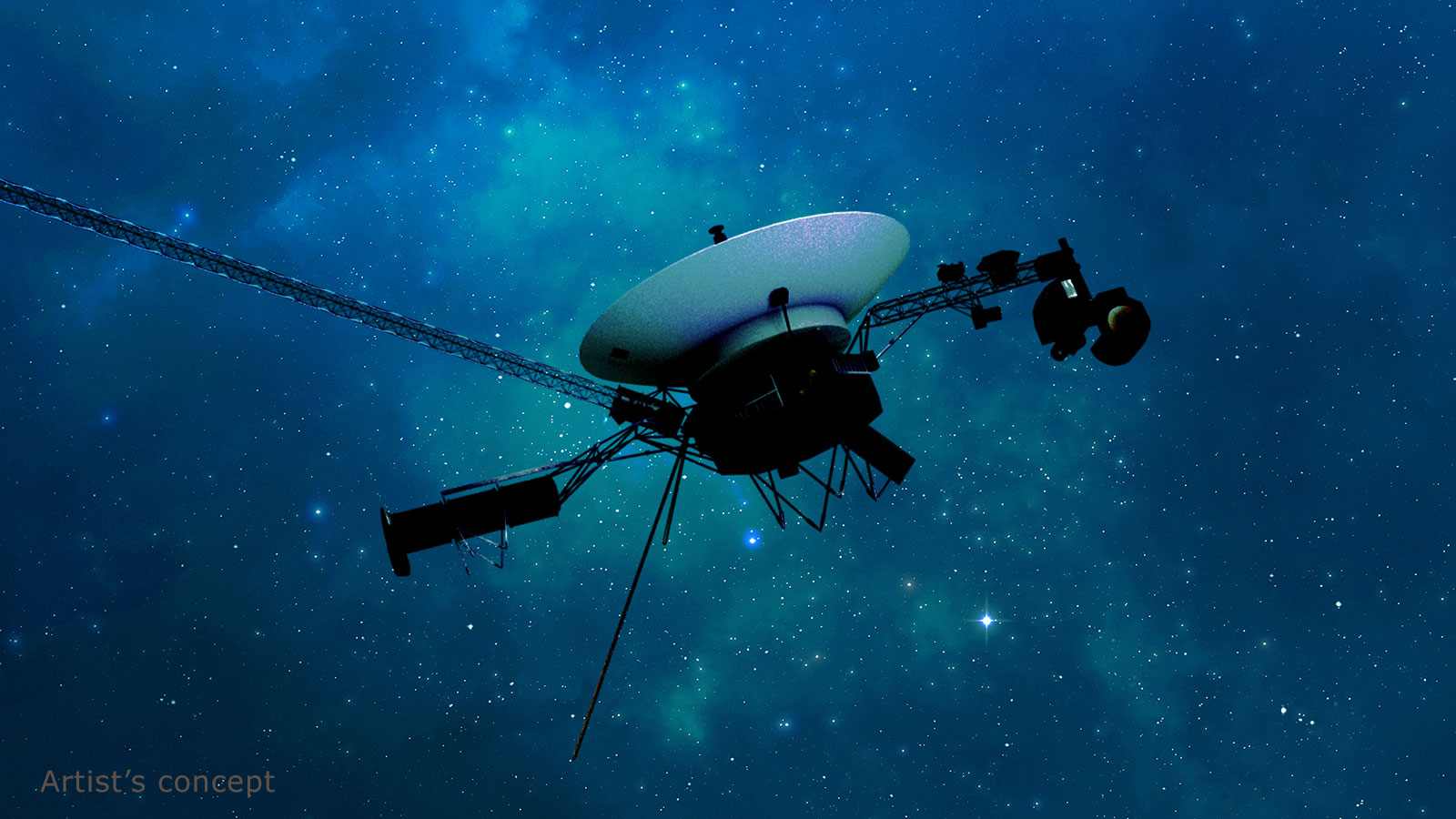
NASA’s Voyager Team Focuses on Software Patch, Thrusters
The efforts should help extend the lifetimes of the agency’s interstellar explorers. Engineers for NASA’s Voyager mission are taking steps to help make sure both spacecraft, launched in 1977, continue to explore interstellar space for years to come. One effort…

NASA Mission Update: Voyager 2 Communications Pause
Once the spacecraft’s antenna is realigned with Earth, communications should resume.
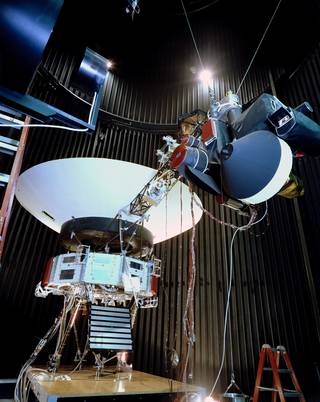
NASA’s Voyager Will Do More Science With New Power Strategy
The plan will keep Voyager 2’s science instruments turned on a few years longer than previously anticipated, enabling yet more revelations from interstellar space.
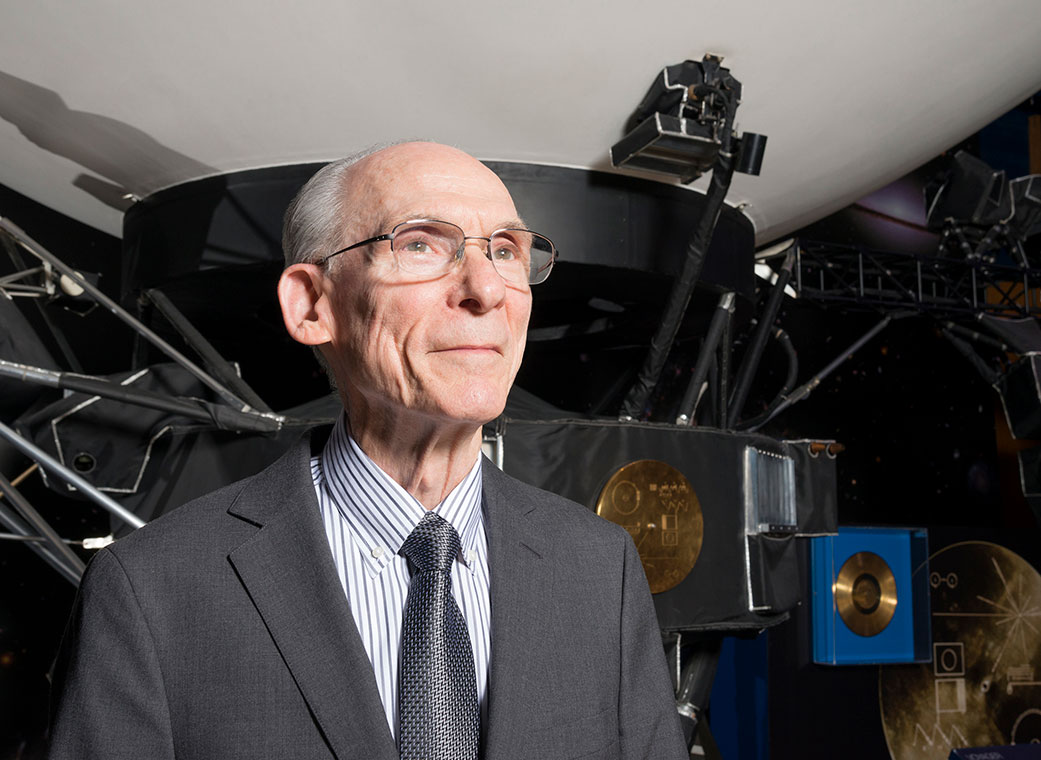
Edward Stone Retires After 50 Years as NASA Voyager’s Project Scientist
Stone’s remarkable tenure on NASA’s longest-operating mission spans decades of historic discoveries and firsts. Edward Stone has retired as the project scientist for NASA’s Voyager mission a half-century after taking on the role. Stone accepted scientific leadership of the historic…
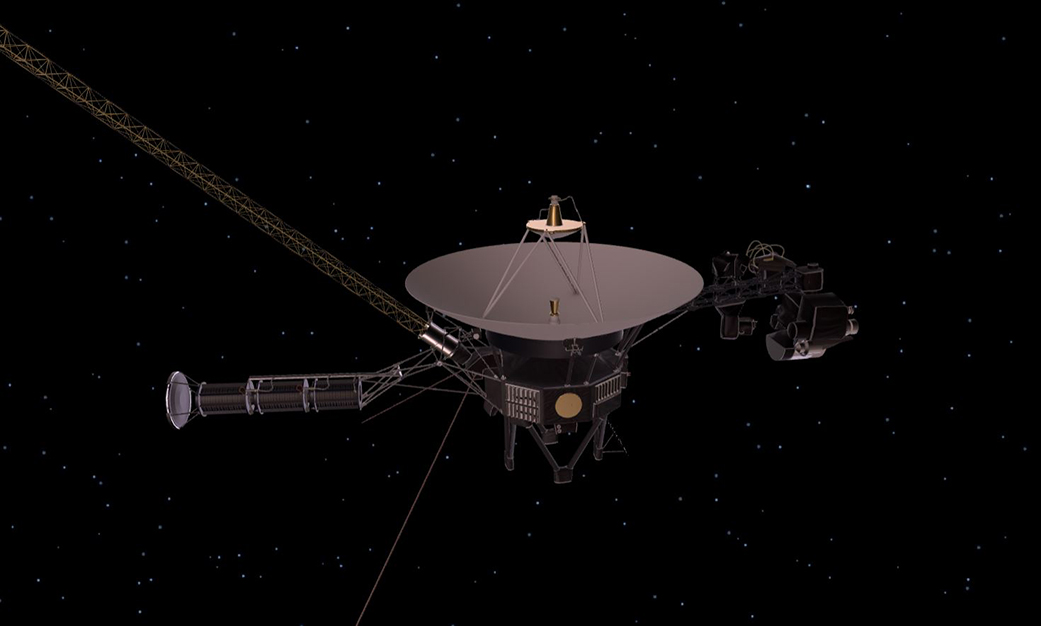
Engineers Solve Data Glitch on NASA’s Voyager 1
A critical system aboard the probe was sending garbled data about its status. Engineers have fixed the issue but are still seeking the root cause. Engineers have repaired an issue affecting data from NASA’s Voyager 1 spacecraft. Earlier this year,…
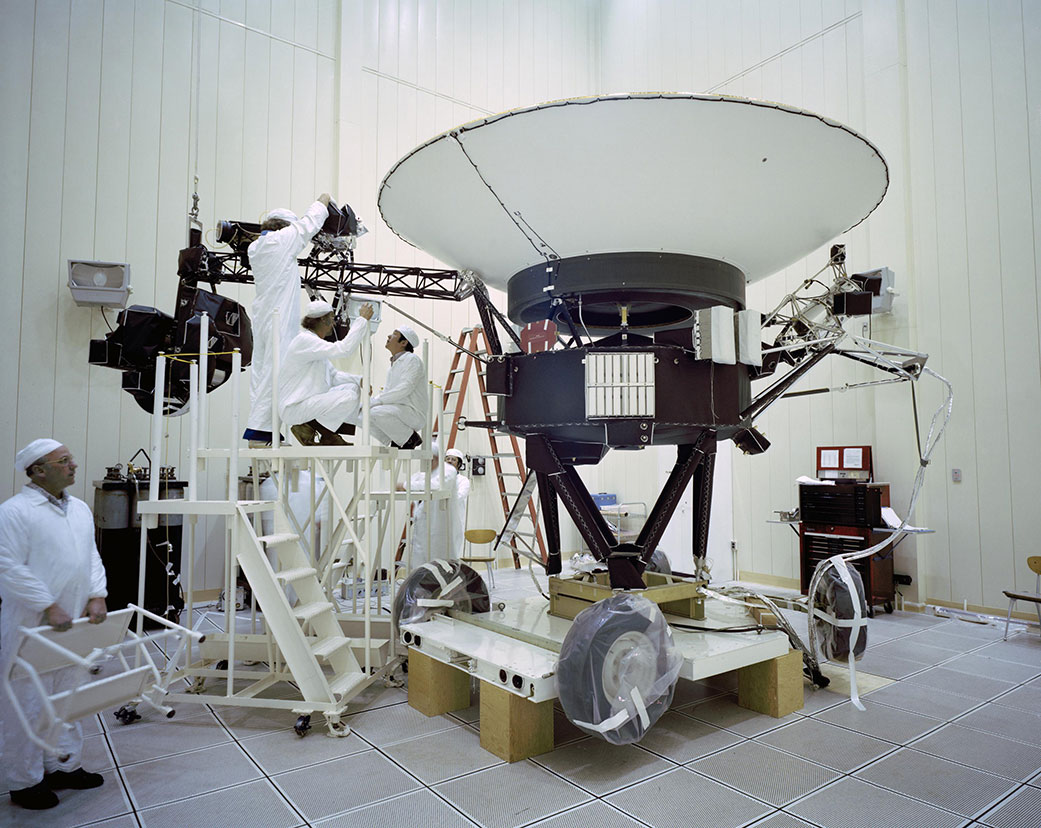
Voyager, NASA’s Longest-Lived Mission, Logs 45 Years in Space
Launched in 1977, the twin Voyager probes are NASA’s longest-operating mission and the only spacecraft ever to explore interstellar space. NASA’s twin Voyager probes have become, in some ways, time capsules of their era: They each carry an eight-track tape…
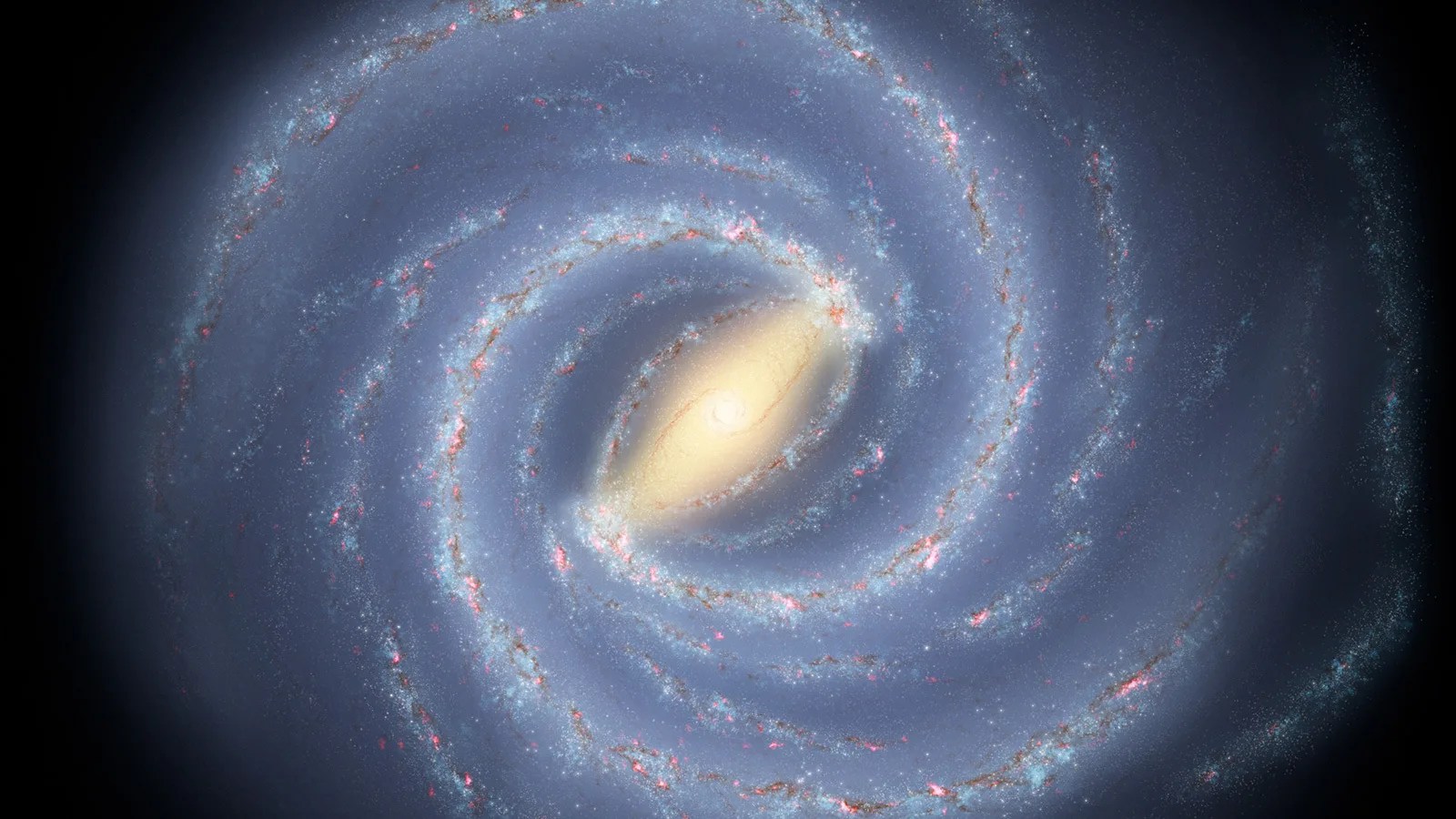
10 Things: Going Interstellar
Humanity’s great leap into interstellar space – the space between the stars – has begun. Here are 10 things we’ve learned about going interstellar.
Inside NASA's 5-month fight to save the Voyager 1 mission in interstellar space

After working for five months to re-establish communication with the farthest-flung human-made object in existence, NASA announced this week that the Voyager 1 probe had finally phoned home.
For the engineers and scientists who work on NASA’s longest-operating mission in space, it was a moment of joy and intense relief.
“That Saturday morning, we all came in, we’re sitting around boxes of doughnuts and waiting for the data to come back from Voyager,” said Linda Spilker, the project scientist for the Voyager 1 mission at NASA’s Jet Propulsion Laboratory in Pasadena, California. “We knew exactly what time it was going to happen, and it got really quiet and everybody just sat there and they’re looking at the screen.”
When at long last the spacecraft returned the agency’s call, Spilker said the room erupted in celebration.
“There were cheers, people raising their hands,” she said. “And a sense of relief, too — that OK, after all this hard work and going from barely being able to have a signal coming from Voyager to being in communication again, that was a tremendous relief and a great feeling.”

The problem with Voyager 1 was first detected in November . At the time, NASA said it was still in contact with the spacecraft and could see that it was receiving signals from Earth. But what was being relayed back to mission controllers — including science data and information about the health of the probe and its various systems — was garbled and unreadable.
That kicked off a monthslong push to identify what had gone wrong and try to save the Voyager 1 mission.
Spilker said she and her colleagues stayed hopeful and optimistic, but the team faced enormous challenges. For one, engineers were trying to troubleshoot a spacecraft traveling in interstellar space , more than 15 billion miles away — the ultimate long-distance call.
“With Voyager 1, it takes 22 1/2 hours to get the signal up and 22 1/2 hours to get the signal back, so we’d get the commands ready, send them up, and then like two days later, you’d get the answer if it had worked or not,” Spilker said.

The team eventually determined that the issue stemmed from one of the spacecraft’s three onboard computers. Spilker said a hardware failure, perhaps as a result of age or because it was hit by radiation, likely messed up a small section of code in the memory of the computer. The glitch meant Voyager 1 was unable to send coherent updates about its health and science observations.
NASA engineers determined that they would not be able to repair the chip where the mangled software is stored. And the bad code was also too large for Voyager 1's computer to store both it and any newly uploaded instructions. Because the technology aboard Voyager 1 dates back to the 1960s and 1970s, the computer’s memory pales in comparison to any modern smartphone. Spilker said it’s roughly equivalent to the amount of memory in an electronic car key.
The team found a workaround, however: They could divide up the code into smaller parts and store them in different areas of the computer’s memory. Then, they could reprogram the section that needed fixing while ensuring that the entire system still worked cohesively.
That was a feat, because the longevity of the Voyager mission means there are no working test beds or simulators here on Earth to test the new bits of code before they are sent to the spacecraft.
“There were three different people looking through line by line of the patch of the code we were going to send up, looking for anything that they had missed,” Spilker said. “And so it was sort of an eyes-only check of the software that we sent up.”
The hard work paid off.
NASA reported the happy development Monday, writing in a post on X : “Sounding a little more like yourself, #Voyager1.” The spacecraft’s own social media account responded , saying, “Hi, it’s me.”
So far, the team has determined that Voyager 1 is healthy and operating normally. Spilker said the probe’s scientific instruments are on and appear to be working, but it will take some time for Voyager 1 to resume sending back science data.
Voyager 1 and its twin, the Voyager 2 probe, each launched in 1977 on missions to study the outer solar system. As it sped through the cosmos, Voyager 1 flew by Jupiter and Saturn, studying the planets’ moons up close and snapping images along the way.
Voyager 2, which is 12.6 billion miles away, had close encounters with Jupiter, Saturn, Uranus and Neptune and continues to operate as normal.
In 2012, Voyager 1 ventured beyond the solar system , becoming the first human-made object to enter interstellar space, or the space between stars. Voyager 2 followed suit in 2018.
Spilker, who first began working on the Voyager missions when she graduated college in 1977, said the missions could last into the 2030s. Eventually, though, the probes will run out of power or their components will simply be too old to continue operating.
Spilker said it will be tough to finally close out the missions someday, but Voyager 1 and 2 will live on as “our silent ambassadors.”
Both probes carry time capsules with them — messages on gold-plated copper disks that are collectively known as The Golden Record . The disks contain images and sounds that represent life on Earth and humanity’s culture, including snippets of music, animal sounds, laughter and recorded greetings in different languages. The idea is for the probes to carry the messages until they are possibly found by spacefarers in the distant future.
“Maybe in 40,000 years or so, they will be getting relatively close to another star,” Spilker said, “and they could be found at that point.”
Denise Chow is a reporter for NBC News Science focused on general science and climate change.
NASA's Voyager probes are slowly shutting down. They launched in 1977 and made it deeper into space than anything since
- NASA is shutting down systems of the Voyager probes to save dwindling power.
- The probes are flagging after 45 years — the move is a way of keeping them going up until 2030.
- Voyager 1 and 2, launched in 1977, have made it farther than any other object made by humans.

The epic interstellar journeys of NASA's acclaimed Voyager probes are due to come to an end as the agency continues to switch off their systems, Scientific American reported.
The probes launched 45 years ago, in 1977, and have pushed the boundaries of space exploration ever since. They're farther away from Earth than any other man-made object, a record that will likely stay unbroken for decades.
The decision to prioritise power allocation on the probes' instruments is meant to extend their life span a few more years and take them to about 2030, Scientific American said.
"We've done 10 times the warranty on the darn things," Ralph McNutt, a physicist at the Johns Hopkins University Applied Physics Laboratory, told the outlet, referring to the initial projections that their mission would last four years.
The probes are powered by radioactive plutonium, which has kept the tiny onboard computers running for decades on end.
The energy in the system is decreasing by about 4 watts a year, Scientific American said, which requires energy use to be cut.
"If everything goes really well, maybe we can get the missions extended into the 2030s. It just depends on the power. That's the limiting point," Linda Spilker, a planetary scientist from the NASA Jet Propulsion Laboratory, told Scientific American.
The probes' primary purpose was to fly by Jupiter and Saturn , a mission that they soon fulfilled. Then they just kept going, sending back images of our solar system and beaming home readings from deep space.
In 1990, Voyager 1 took the iconic "Pale Blue Dot" composite picture, a view of Earth taken 3.7 billion miles away from our sun.
Related stories
More striking pictures taken by the probes are seen in the video below.
In 1998, Voyager 1 became the farthest human-made object in space — 6.5 billion miles from Earth.
The probes are now 12 billion and 14.5 billion miles away from Earth and counting, a live tracker from NASA shows.
That is beyond what is generally considered to be the limits of our solar system. Voyager 1 reached "interstellar space" in 2012 and Voyager 2 in 2018 — the first human objects to do so in history.
The instrument's hardwired electronics have survived the test of time remarkably well, in spite of its age.
The primitive computers onboard the probes don't require much power. All of the data collected by the instruments on Voyager is stored on an eight-track tape recorder and sent to earth using a machine that uses up about as much power as a refrigerator light bulb, Scientific American said.
They have "less memory than the key fob that opens your car door," Spilker said.
As energy on board is dwindling, NASA is deciding which instruments will get the power.
After 2030, Voyager will likely lose its ability to communicate with Earth. But that doesn't necessarily mean its mission will be over.
They both carry a "golden record," a 12-inch, gold-plated record that carries information about Earth.
This includes 115 images ; greetings in 55 different languages; sounds , including wind, rain, and the human heartbeat; and 90 minutes of music .
It will be about another 20,000 years before the probes pass the nearest star, Proxima Centauri, with this time capsule of human life, Scientific American reported.
Editor's note: This story was updated on June 23, 2022, to clarify that the powering down of systems on the Voyager probes is a years-long process that is continuing. A previous version, citing Scientific American, said that a new decision to power down systems was due this year.
Watch: NASA's $1 billion Dragonfly drone mission will look for signs of life on Saturn's moon
- Main content
After months of silence, Voyager 1 has returned NASA’s calls

- Show more sharing options
- Copy Link URL Copied!
For the last five months, it seemed very possible that a 46-year-old conversation had finally reached its end.
Since its launch from Kennedy Space Center on Sept. 5, 1977, NASA’s Voyager 1 spacecraft has diligently sent regular updates to Earth on the health of its systems and data collected from its onboard instruments.
But in November, the craft went quiet.
Voyager 1 is now some 15 billion miles away from Earth. Somewhere in the cold interstellar space between our sun and the closest stars, its flight data system stopped communicating with the part of the probe that allows it to send signals back to Earth. Engineers at the Jet Propulsion Laboratory in La Cañada Flintridge could tell that Voyager 1 was getting its messages, but nothing was coming back.
“We’re to the point where the hardware is starting to age,” said Linda Spilker, the project scientist for the Voyager mission. “It’s like working on an antique car, from 15 billion miles away.”
Week after week, engineers sent troubleshooting commands to the spacecraft, each time patiently waiting the 45 hours it takes to get a response here on Earth — 22.5 hours traveling at the speed of light to reach the probe, and 22.5 hours back.

Science & Medicine
This space artist created the Golden Record and changed the way we see the universe
Space artist Jon Lomberg has produced work that attempts to visualize what we can’t truly see, and to communicate with creatures we can’t yet imagine.
July 26, 2023
By March, the team had figured out that a memory chip that stored some of the flight data system’s software code had failed, turning the craft’s outgoing communications into gibberish.
A long-distance repair wasn’t possible. There wasn’t enough space anywhere in the system to shift the code in its entirety. So after manually reviewing the code line by line, engineers broke it up and tucked the pieces into the available slots of memory.
They sent a command to Voyager on Thursday. In the early morning hours Saturday, the team gathered around a conference table at JPL: laptops open, coffee and boxes of doughnuts in reach.
At 6:41 a.m., data from the craft showed up on their screens. The fix had worked .
“We went from very quiet and just waiting patiently to cheers and high-fives and big smiles and sighs of relief,” Spilker said. “I’m very happy to once again have a meaningful conversation with Voyager 1.”
Voyager 1 is one of two identical space probes. Voyager 2, launched two weeks before Voyager 1, is now about 13 billion miles from Earth, the two crafts’ trajectories having diverged somewhere around Saturn. (Voyager 2 continued its weekly communications uninterrupted during Voyager 1’s outage.)

Space shuttle Endeavour is lifted into the sky, takes final position as star of new museum wing
A shrink-wrapped Endeavour was hoisted and then carefully placed in its final location Tuesday at the still-under-construction Samuel Oschin Air and Space Center.
Jan. 30, 2024
They are the farthest-flung human-made objects in the universe, having traveled farther from their home planet than anything else this species has built. The task of keeping communications going grows harder with each passing day. Every 24 hours, Voyager 1 travels 912,000 miles farther away from us. As that distance grows, the signal becomes slower and weaker.
When the probe visited Jupiter in 1979, it was sending back data at a rate of 115.2 kilobits per second, Spilker said. Today, 45 years and more than 14 billion miles later, data come back at a rate of 40 bits per second.
The team is cautiously optimistic that the probes will stay in contact for three more years, long enough to celebrate the mission’s 50th anniversary in 2027, Spilker said. They could conceivably last until the 2030s.
The conversation can’t last forever. Microscopic bits of silica keep clogging up the thrusters that keep the probes’ antennas pointed toward Earth, which could end communications. The power is running low. Eventually, the day will come when both Voyagers stop transmitting data to Earth, and the first part of their mission ends.
But on the day each craft goes quiet, they begin a new era, one that could potentially last far longer. Each probe is equipped with a metallic album cover containing a Golden Record , a gold-plated copper disk inscribed with sounds and images meant to describe the species that built the Voyagers and the planet they came from.
Erosion in space is negligible; the images could be readable for another billion years or more. Should any other intelligent life form encounter one of the Voyager probes and have a means of retrieving the data from the record, they will at the very least have a chance to figure out who sent them — even if our species is by that time long gone.
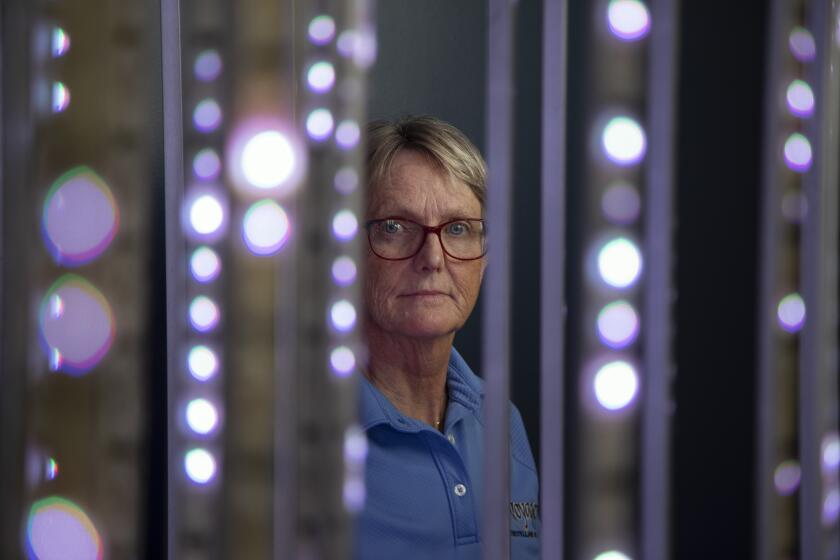
JPL tries to keep Voyager space probes from disconnecting the world’s longest phone call
Keeping in touch with NASA’s two aging Voyager spacecraft is getting harder to do as they get farther away and their power sources dwindle.
Sept. 3, 2022
More to Read

Too expensive, too slow: NASA asks for help with JPL’s Mars Sample Return mission
April 15, 2024

NASA’s attempt to bring home part of Mars is unprecedented. The mission’s problems are not
March 25, 2024
Budget deal for NASA offers glimmer of hope for JPL’s Mars Sample Return mission
March 6, 2024

Corinne Purtill is a science and medicine reporter for the Los Angeles Times. Her writing on science and human behavior has appeared in the New Yorker, the New York Times, Time Magazine, the BBC, Quartz and elsewhere. Before joining The Times, she worked as the senior London correspondent for GlobalPost (now PRI) and as a reporter and assignment editor at the Cambodia Daily in Phnom Penh. She is a native of Southern California and a graduate of Stanford University.
More From the Los Angeles Times

More than 50 are injured when L.A. Metro train, bus collide outside Exposition Park
April 30, 2024

A 17-year-old girl was fatally shot while walking home in Long Beach. Police release video of a suspect

The scrappiest place on Earth? Altercation at Disney California Adventure leads to ejection

Why the Lakers lost their last timeout despite successful challenge against Nuggets
- Mobile Site
- Staff Directory
- Advertise with Ars
Filter by topic
- Biz & IT
- Gaming & Culture
Front page layout
Volatile —
Humanity’s most distant space probe jeopardized by computer glitch, "it would be the biggest miracle if we get it back. we certainly haven't given up.".
Stephen Clark - Feb 6, 2024 10:04 pm UTC
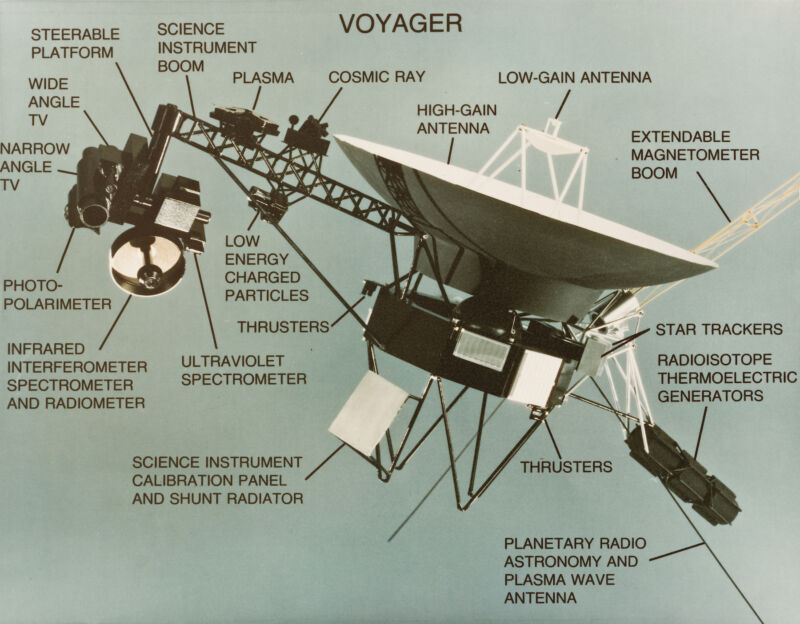
Voyager 1 is still alive out there, barreling into the cosmos more than 15 billion miles away. However, a computer problem has kept the mission's loyal support team in Southern California from knowing much more about the status of one of NASA's longest-lived spacecraft.
The computer glitch cropped up on November 14, and it affected Voyager 1's ability to send back telemetry data, such as measurements from the spacecraft's science instruments or basic engineering information about how the probe was doing. So, there's no insight into key parameters regarding the craft's propulsion, power, or control systems.
"It would be the biggest miracle if we get it back. We certainly haven't given up," said Suzanne Dodd, Voyager project manager at NASA's Jet Propulsion Laboratory, in an interview with Ars. "There are other things we can try. But this is, by far, the most serious since I’ve been project manager."
Dodd became the project manager for NASA's Voyager mission in 2010, overseeing a small cadre of engineers responsible for humanity's exploration into interstellar space. Voyager 1 is the most distant spacecraft ever, speeding away from the Sun at 38,000 mph (17 kilometers per second).
Voyager 2, which launched 16 days before Voyager 1 in 1977, isn't quite as far away. It took a more leisurely route through the Solar System, flying past Jupiter, Saturn, Uranus, and Neptune, while Voyager 1 picked up speed during an encounter with Saturn to overtake its sister spacecraft.
For the last couple of decades, NASA has devoted Voyager's instruments to studying cosmic rays, the magnetic field, and the plasma environment in interstellar space. They're not taking pictures anymore. Both probes have traveled beyond the heliopause, where the flow of particles emanating from the Sun runs into the interstellar medium.
There are no other operational spacecraft currently exploring interstellar space. NASA's New Horizons probe, which flew past Pluto in 2015, is on track to reach interstellar space in the 2040s.
State-of-the-art 50 years ago
The latest problem with Voyager 1 lies in the probe's Flight Data Subsystem (FDS), one of three computers on the spacecraft working alongside a command-and-control central computer and another device overseeing attitude control and pointing.
The FDS is responsible for collecting science and engineering data from the spacecraft's network of sensors and then combining the information into a single data package in binary code—a series of ones and zeros. A separate component called the Telemetry Modulation Unit actually sends the data package back to Earth through Voyager's 12-foot (3.7-meter) dish antenna.
In November, the data packages transmitted by Voyager 1 manifested a repeating pattern of ones and zeros as if it were stuck, according to NASA. Dodd said engineers at JPL have spent the better part of three months trying to diagnose the cause of the problem. She said the engineering team is "99.9 percent sure" the problem originated in the FDS, which appears to be having trouble "frame syncing" data.

So far, the ground team believes the most likely explanation for the problem is a bit of corrupted memory in the FDS. However, because of the computer hangup, engineers lack detailed data from Voyager 1 that might lead them to the root of the issue. "It's likely somewhere in the FDS memory," Dodd said. "A bit got flipped or corrupted. But without the telemetry, we can't see where that FDS memory corruption is."
When it was developed five decades ago, Voyager's Flight Data Subsystem was an innovation in computing. It was the first computer on a spacecraft to make use of volatile memory. Each Voyager spacecraft launched with two FDS computers, but Voyager 1's backup FDS failed in 1981, according to Dodd.
The only signal Voyager 1's Earthbound engineers have received since November is a carrier tone, which basically tells the team the spacecraft is still alive. There's no indication of any other major problems. Changes in the carrier signal's modulation indicate Voyager 1 is receiving commands uplinked from Earth.
"Unfortunately, we haven't cracked the nut yet, or solved the problem, or gotten any telemetry back," Dodd said.
reader comments
Channel ars technica.
- Skip to main content
- Keyboard shortcuts for audio player
Good news from Voyager 1, which is now out past the edge of the solar system

Nell Greenfieldboyce
In mid-November, Voyager 1 suffered a glitch, and it's messages stopped making sense. But the NASA probe is once again sending messages to Earth that make sense.
Copyright © 2024 NPR. All rights reserved. Visit our website terms of use and permissions pages at www.npr.org for further information.
NPR transcripts are created on a rush deadline by an NPR contractor. This text may not be in its final form and may be updated or revised in the future. Accuracy and availability may vary. The authoritative record of NPR’s programming is the audio record.
- Election 2024
- Entertainment
- Newsletters
- Photography
- Personal Finance
- AP Investigations
- AP Buyline Personal Finance
- AP Buyline Shopping
- Press Releases
- Israel-Hamas War
- Russia-Ukraine War
- Global elections
- Asia Pacific
- Latin America
- Middle East
- Election Results
- Delegate Tracker
- AP & Elections
- Auto Racing
- 2024 Paris Olympic Games
- Movie reviews
- Book reviews
- Personal finance
- Financial Markets
- Business Highlights
- Financial wellness
- Artificial Intelligence
- Social Media
NASA hears from Voyager 1, the most distant spacecraft from Earth, after months of quiet
This illustration provided by NASA depicts Voyager 1. The most distant spacecraft from Earth stopped sending back understandable data in November 2023. Flight controllers traced the blank communication to a bad computer chip and rearranged the spacecraft’s coding to work around the trouble. In mid-April 2024, NASA’s Jet Propulsion Laboratory declared success after receiving good engineering updates. The team is still working to restore transmission of the science data. (NASA via AP)
- Copy Link copied
CAPE CANAVERAL, Fla. (AP) — NASA has finally heard back from Voyager 1 again in a way that makes sense.
The most distant spacecraft from Earth stopped sending back understandable data last November. Flight controllers traced the blank communication to a bad computer chip and rearranged the spacecraft’s coding to work around the trouble.
NASA’s Jet Propulsion Laboratory in Southern California declared success after receiving good engineering updates late last week. The team is still working to restore transmission of the science data.
It takes 22 1/2 hours to send a signal to Voyager 1, more than 15 billion miles (24 billion kilometers) away in interstellar space. The signal travel time is double that for a round trip.
Contact was never lost, rather it was like making a phone call where you can’t hear the person on the other end, a JPL spokeswoman said Tuesday.
Launched in 1977 to study Jupiter and Saturn, Voyager 1 has been exploring interstellar space — the space between star systems — since 2012. Its twin, Voyager 2, is 12.6 billion miles (20 billion kilometers) away and still working fine.
The Associated Press Health and Science Department receives support from the Howard Hughes Medical Institute’s Science and Educational Media Group. The AP is solely responsible for all content.
- Work & Careers
- Life & Arts
Become an FT subscriber
Try unlimited access Only $1 for 4 weeks
Then $75 per month. Complete digital access to quality FT journalism on any device. Cancel anytime during your trial.
- Global news & analysis
- Expert opinion
- Special features
- FirstFT newsletter
- Videos & Podcasts
- Android & iOS app
- FT Edit app
- 10 gift articles per month
Explore more offers.
Standard digital.
- FT Digital Edition
Premium Digital
Print + premium digital, weekend print + standard digital, weekend print + premium digital.
Today's FT newspaper for easy reading on any device. This does not include ft.com or FT App access.
- 10 additional gift articles per month
- Global news & analysis
- Exclusive FT analysis
- Videos & Podcasts
- FT App on Android & iOS
- Everything in Standard Digital
- Premium newsletters
- Weekday Print Edition
- FT Weekend Print delivery
- Everything in Premium Digital
Essential digital access to quality FT journalism on any device. Pay a year upfront and save 20%.
- Everything in Print
Complete digital access to quality FT journalism with expert analysis from industry leaders. Pay a year upfront and save 20%.
Terms & Conditions apply
Explore our full range of subscriptions.
Why the ft.
See why over a million readers pay to read the Financial Times.
International Edition

Russia's Deputy Defense Minister Arrested in Corruption Probe
R ussia's Deputy Defense Minister Timur Ivanov was arrested on suspicion of taking bribes on Tuesday, marking a rare arrest of a member of the Kremlin's elite.
"Deputy Minister of Defense of the Russian Federation Timur Vadimovich Ivanov has been detained on suspicion of committing a crime under Part 6 of Article 290 of the Criminal Code [taking a bribe]," Russia's Investigative Committee said on Telegram on Tuesday evening, without elaborating.
Ivanov, who has been sanctioned by the U.S. and the EU , has held the post of Russian deputy defense minister since May 2016. His role includes asset management, overseeing the construction of ministry facilities, providing medical support for Russia's military, and managing troop housing.
According to Russia's state-run news agency Tass, the section under the Criminal Code under which Ivanov was arrested applies to bribes over 1 million rubles ($10,800).
He is accused of receiving a bribe "on an especially large scale as part of an organized group while carrying out contract and subcontract work for the needs of the military department," the press service of the Moscow City Court told Tass.
Ivanov will be held at a pre-trial detention for a period of two months, until June 23, and if convicted, he faces up to 15 years in jail.
His detention was reported to Russian President Vladimir Putin , Kremlin spokesperson Dmitry Peskov said.
Newsweek has contacted Russia's Defense Ministry for comment by email.
The court said it also detained an individual named Sergei Borodin, who is accused of being complicit in receiving a bribe.
"Borodin, being in friendly relations with the Deputy Defense Minister of the Russian Federation Ivanov, who oversaw the construction and major repairs of facilities of the Ministry of Defense, entered into a criminal conspiracy with third parties, teamed up with them in advance to commit an organized group of a crime—receiving a bribe on a particularly large scale in the form of provision of property services during contracting and subcontracting work for the needs of the Ministry of Defense," the Moscow City Court statement said.
X (formerly Twitter ) user Dmitri, from War Translated, an independent project that translates materials about the war, said he thinks Ivanov's arrest is a "sensitive attack" against Russian Defense Minister Sergei Shoigu .
"Without Putin's sanction, such an arrest was impossible. Ivanov is one of Shoigu's 12 deputies," he said.
Do you have a tip on a world news story that Newsweek should be covering? Do you have a question about the Russia-Ukraine war? Let us know via [email protected].
Related Articles
- Russia Drops X-59 Missile on Belgorod in Latest Self-Bombing
- Russia Plans 'Strategic' Economy Boost in Arctic
- Sweden's Navy Chief Says Russian Shadow Fleet 'Spying' in NATO Lake
Start your unlimited Newsweek trial


COMMENTS
Voyager 6 was a deep space probe launched from Earth by the National Aeronautics and Space Administration (NASA) in the latter half of the 20th century. The sixth probe in the Voyager series, it was designed to collect data and transmit it back to Earth. ( Star Trek: The Motion Picture )
A poster of the planets and moons visited during the Voyager program. The Voyager program is an American scientific program that employs two interstellar probes, Voyager 1 and Voyager 2.They were launched in 1977 to take advantage of a favorable alignment of the two gas giants Jupiter and Saturn and the ice giants, Uranus and Neptune, to fly near them while collecting data for transmission ...
Both Voyager 1 and Voyager 2 have reached "Interstellar space" and each continue their unique journey through the Universe. In the NASA Eyes on the Solar System app, you can see the real spacecraft trajectories of the Voyagers, which are updated every five minutes. Distance and velocities are updated in real-time.
Both Voyager probes have outlived their original missions and are exploring interstellar space more than 45 years after launch. The mission team has made clever decisions to manage the power ...
Mission Overview. The twin Voyager 1 and 2 spacecraft are exploring where nothing from Earth has flown before. Continuing on their more-than-40-year journey since their 1977 launches, they each are much farther away from Earth and the sun than Pluto. In August 2012, Voyager 1 made the historic entry into interstellar space, the region between ...
This is a real-time indicator of Voyager 1's distance from Earth in astronomical units (AU) and either miles (mi) or kilometers (km). Note: Because Earth moves around the sun faster than Voyager 1 is speeding away from the inner solar system, the distance between Earth and the spacecraft actually decreases at certain times of year.
Star Trek: The Motion Picture featured a character named V'Ger. The sentient, creator-seeking entity was actually the Voyager 6, a fictitious 20th-century probe that disappeared into a black hole, where a race a living machines eventually breathed life into it. That set V'Ger on its destructive path and on to a date with destiny in the form ...
Launched in 1977, the twin Voyager probes are NASA's longest-operating mission and the only spacecraft ever to explore interstellar space. NASA's twin Voyager probes have become, in some ways, time capsules of their era: They each carry an eight-track tape player for recording data, they have about 3 million times less memory than modern cellphones, and they transmit data about 38,000 ...
In Star Trek: The Motion Picture, an entity named V'ger shows up wreaking havoc in the Sol System. Through some inquiry, investigation and risk taking, the Enterprise crew figures out that it is in fact NASA's Voyager space probe, which had met a machine race somewhere in deep space (possibly the Delta Quadrant).
The probe and its twin, Voyager 2, are the only spacecraft to ever fly in interstellar space (the space between stars). Voyager 1 stopped sending readable science and engineering data back to Earth on Nov. 14, 2023, even though mission controllers could tell the spacecraft was still receiving their commands and otherwise operating normally. In ...
Background. The Voyager 1 probe is currently the farthest human-made object from Earth.Both Voyager 1 and Voyager 2 have reached interstellar space, the region between stars where the galactic plasma is present. Like their predecessors Pioneer 10 and 11, which featured a simple plaque, both Voyager 1 and Voyager 2 were launched by NASA with a message aboard—a kind of time capsule, intended ...
The Voyager 1 and Voyager 2 space probes launched 45 years ago, the first on Aug. 20, 1977 and the second on Sept. 5, and they are now the farthest human-made objects from Earth, at about three ...
In 1979, Paramount Pictures released "Star Trek: The Motion Picture." In this first big-screen outing of the "Star Trek" franchise, IMDb tells us that the crew of the Enterprise face off against an enormous alien spacecraft called V'ger, a living machine. In the climax, it is discovered that V'ger is none other than Voyager 6, a probe from the famed 20th-century Voyager missions.
Voyager 6 (V'ger) was created and launched into space in the late 20th century. The Borg were in existence long before NASA was created, 500 years or more. Even if the "black hole" had time warped Voyager 6 back 500 years in the wrong direction it was originally heading, the technology differences are massive.
Launched in 1977, the twin Voyager probes are NASA 's longest-operating mission and the only spacecraft ever to explore interstellar space.. Launched in 1977, NASA's twin Voyager spacecraft inspired the world with pioneering visits to Jupiter, Saturn, Uranus, and Neptune.Their journey continues 45 years later as both probes explore interstellar space, the region outside the protective ...
Launched in 1977, the twin Voyager probes are NASA's longest-operating mission and the only spacecraft ever to explore interstellar space. NASA's twin Voyager probes have become, in some ways, time capsules of their era: They each carry an eight-track tape…
A Titan/Centaur-6 launch vehicle carries NASA's Voyager 1 at the Kennedy Space Center on Sept. 5, 1977. NASA The team eventually determined that the issue stemmed from one of the spacecraft's ...
In 1998, Voyager 1 became the farthest human-made object in space — 6.5 billion miles from Earth. The probes are now 12 billion and 14.5 billion miles away from Earth and counting, a live ...
Since its launch from Kennedy Space Center on Sept. 5, 1977, NASA's Voyager 1 spacecraft has diligently sent regular updates to Earth on the health of its systems and data collected from its ...
Voyager 1 is the most distant spacecraft ever, speeding away from the Sun at 38,000 mph (17 kilometers per second). Voyager 2, which launched 16 days before Voyager 1 in 1977, isn't quite as far ...
Good news from Voyager 1, which is now out past the edge of the solar system In mid-November, Voyager 1 suffered a glitch, and it's messages stopped making sense. But the NASA probe is once again ...
Updated 12:58 PM PDT, April 23, 2024. CAPE CANAVERAL, Fla. (AP) — NASA has finally heard back from Voyager 1 again in a way that makes sense. The most distant spacecraft from Earth stopped sending back understandable data last November. Flight controllers traced the blank communication to a bad computer chip and rearranged the spacecraft's ...
The craft embodies a golden age of space exploration. The writer is a science commentator. A ghost has come back to life. Voyager 1, a spacecraft dispatched in the 1970s that had been sending ...
Early history (1147-1283) The first reference to Moscow dates from 1147 as a meeting place of Sviatoslav Olgovich and Yuri Dolgorukiy. At the time it was a minor town on the western border of Vladimir-Suzdal Principality. In 1156, Kniaz Yury Dolgoruky fortified the town with a timber fence and a moat.
The agenda and packet for this meeting are available at http://www.ci.moscow.id.us/AgendaCenter
On 22 March 2024, a terrorist attack which was carried out by the Islamic State (IS) occurred at the Crocus City Hall music venue in Krasnogorsk, Moscow Oblast, Russia.. The attack began at around 20:00 MSK (), shortly before the Russian band Picnic was scheduled to play a sold-out show at the venue. Four gunmen carried out a mass shooting, as well as slashing attacks on the people gathered at ...
Russia's Deputy Defense Minister Arrested in Corruption Probe. ... of the Russian Federation Timur Vadimovich Ivanov has been detained on suspicion of committing a crime under Part 6 of Article ...